Research Project: Information System for Budgeting Analysis
VerifiedAdded on 2022/08/23
|33
|6595
|33
Project
AI Summary
This research project investigates the need for a new information system for budgeting at Transit Business Line. It begins by outlining the problem: the current system, relying on manual data entry and Excel sheets, is inefficient. The project sets aims and objectives, including assessing the current system's drawbacks, the pros and cons of automation, and potential limitations. A comprehensive literature review explores existing research on information processing systems, knowledge maps, and competitive advantage. The methodology involves outlining the research philosophy, design, data collection, and analysis methods. The findings and discussion analyze the disadvantages of the manual system, the advantages and disadvantages of introducing an automated system, and limitations of the transition. The project concludes with recommendations for the new information system, aiming to improve efficiency and accuracy in budgeting processes. The project provides a thorough analysis of the current issues and potential solutions.
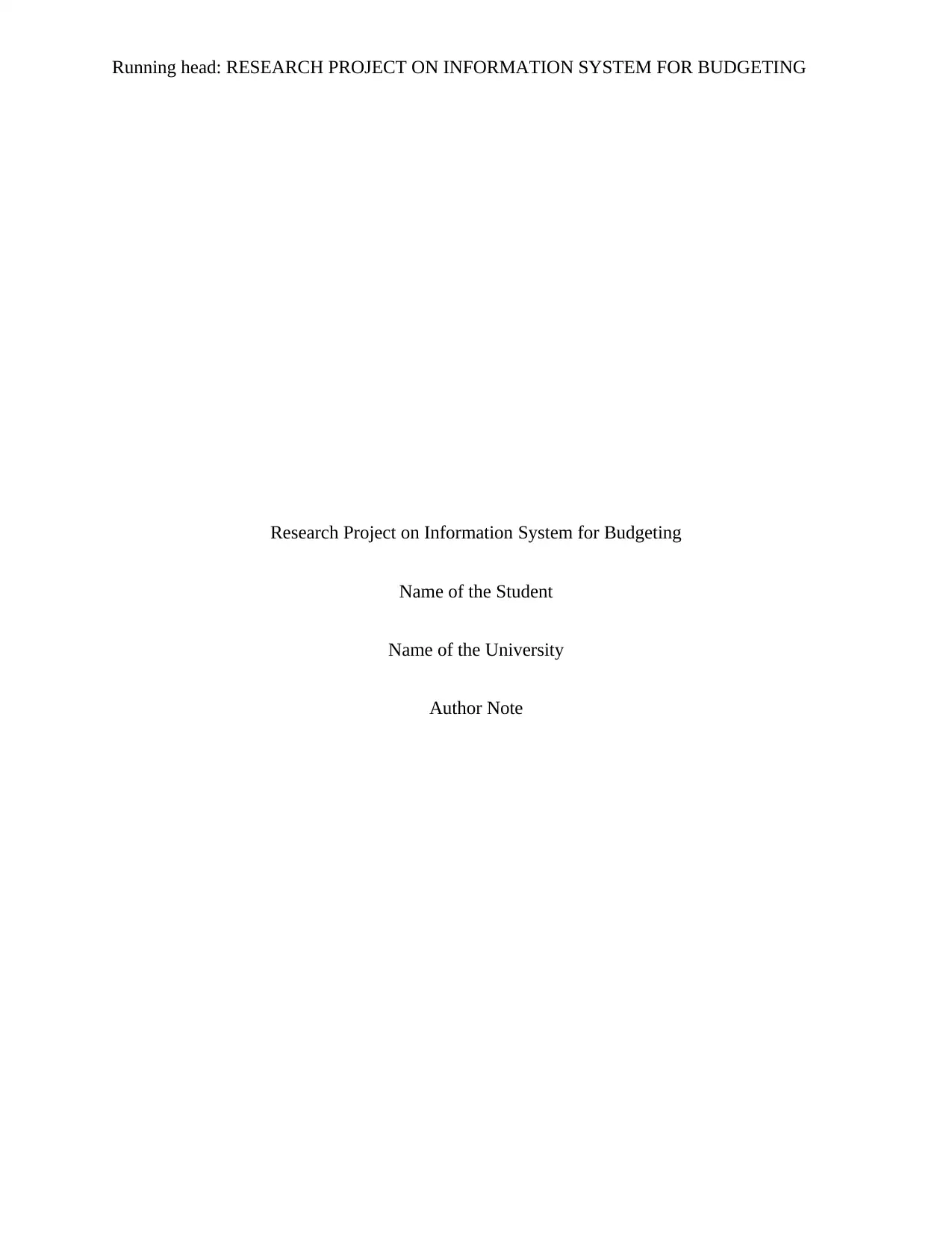
Running head: RESEARCH PROJECT ON INFORMATION SYSTEM FOR BUDGETING
Research Project on Information System for Budgeting
Name of the Student
Name of the University
Author Note
Research Project on Information System for Budgeting
Name of the Student
Name of the University
Author Note
Paraphrase This Document
Need a fresh take? Get an instant paraphrase of this document with our AI Paraphraser
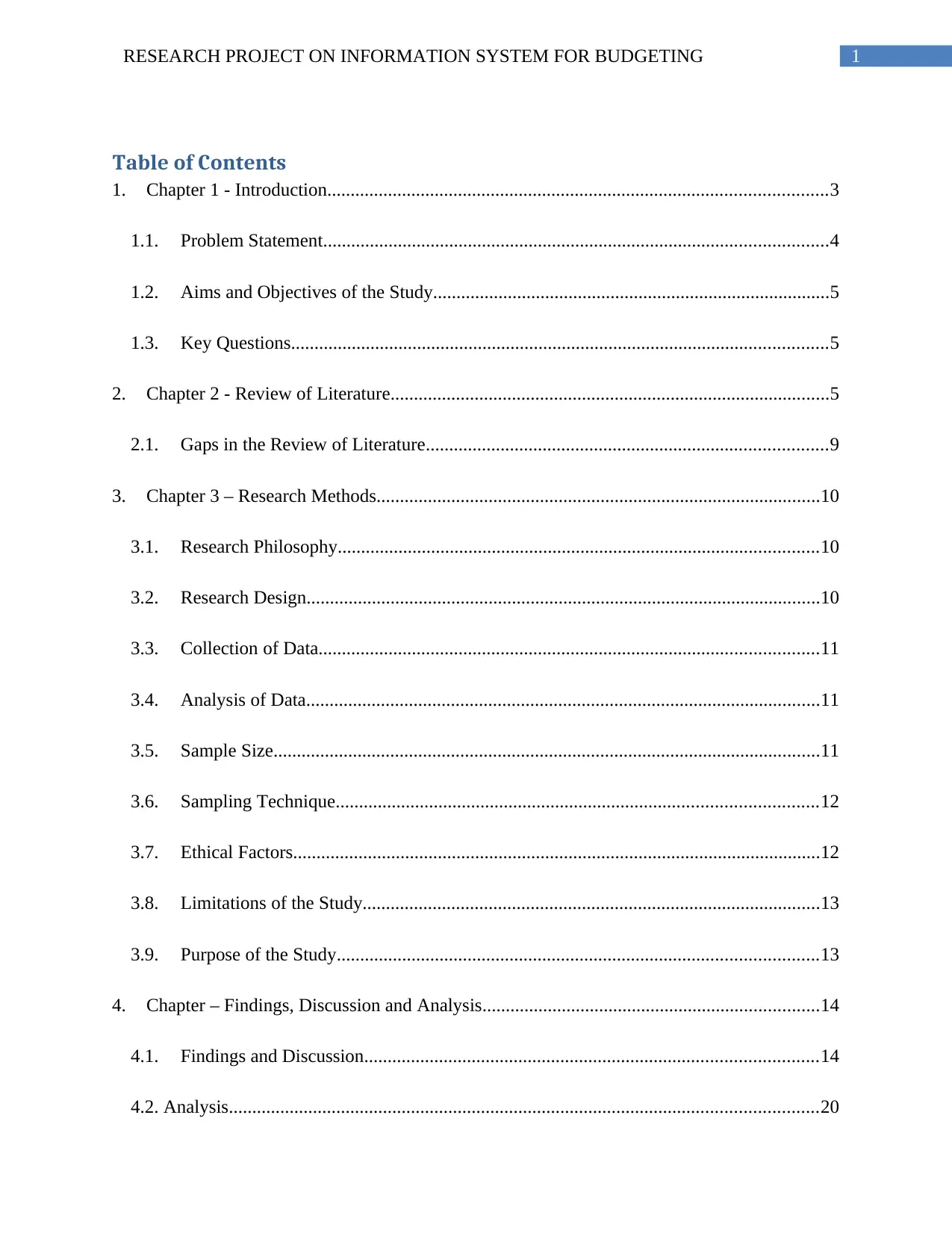
1RESEARCH PROJECT ON INFORMATION SYSTEM FOR BUDGETING
Table of Contents
1. Chapter 1 - Introduction...........................................................................................................3
1.1. Problem Statement............................................................................................................4
1.2. Aims and Objectives of the Study.....................................................................................5
1.3. Key Questions...................................................................................................................5
2. Chapter 2 - Review of Literature..............................................................................................5
2.1. Gaps in the Review of Literature......................................................................................9
3. Chapter 3 – Research Methods...............................................................................................10
3.1. Research Philosophy.......................................................................................................10
3.2. Research Design..............................................................................................................10
3.3. Collection of Data...........................................................................................................11
3.4. Analysis of Data..............................................................................................................11
3.5. Sample Size.....................................................................................................................11
3.6. Sampling Technique.......................................................................................................12
3.7. Ethical Factors.................................................................................................................12
3.8. Limitations of the Study..................................................................................................13
3.9. Purpose of the Study.......................................................................................................13
4. Chapter – Findings, Discussion and Analysis........................................................................14
4.1. Findings and Discussion.................................................................................................14
4.2. Analysis..............................................................................................................................20
Table of Contents
1. Chapter 1 - Introduction...........................................................................................................3
1.1. Problem Statement............................................................................................................4
1.2. Aims and Objectives of the Study.....................................................................................5
1.3. Key Questions...................................................................................................................5
2. Chapter 2 - Review of Literature..............................................................................................5
2.1. Gaps in the Review of Literature......................................................................................9
3. Chapter 3 – Research Methods...............................................................................................10
3.1. Research Philosophy.......................................................................................................10
3.2. Research Design..............................................................................................................10
3.3. Collection of Data...........................................................................................................11
3.4. Analysis of Data..............................................................................................................11
3.5. Sample Size.....................................................................................................................11
3.6. Sampling Technique.......................................................................................................12
3.7. Ethical Factors.................................................................................................................12
3.8. Limitations of the Study..................................................................................................13
3.9. Purpose of the Study.......................................................................................................13
4. Chapter – Findings, Discussion and Analysis........................................................................14
4.1. Findings and Discussion.................................................................................................14
4.2. Analysis..............................................................................................................................20
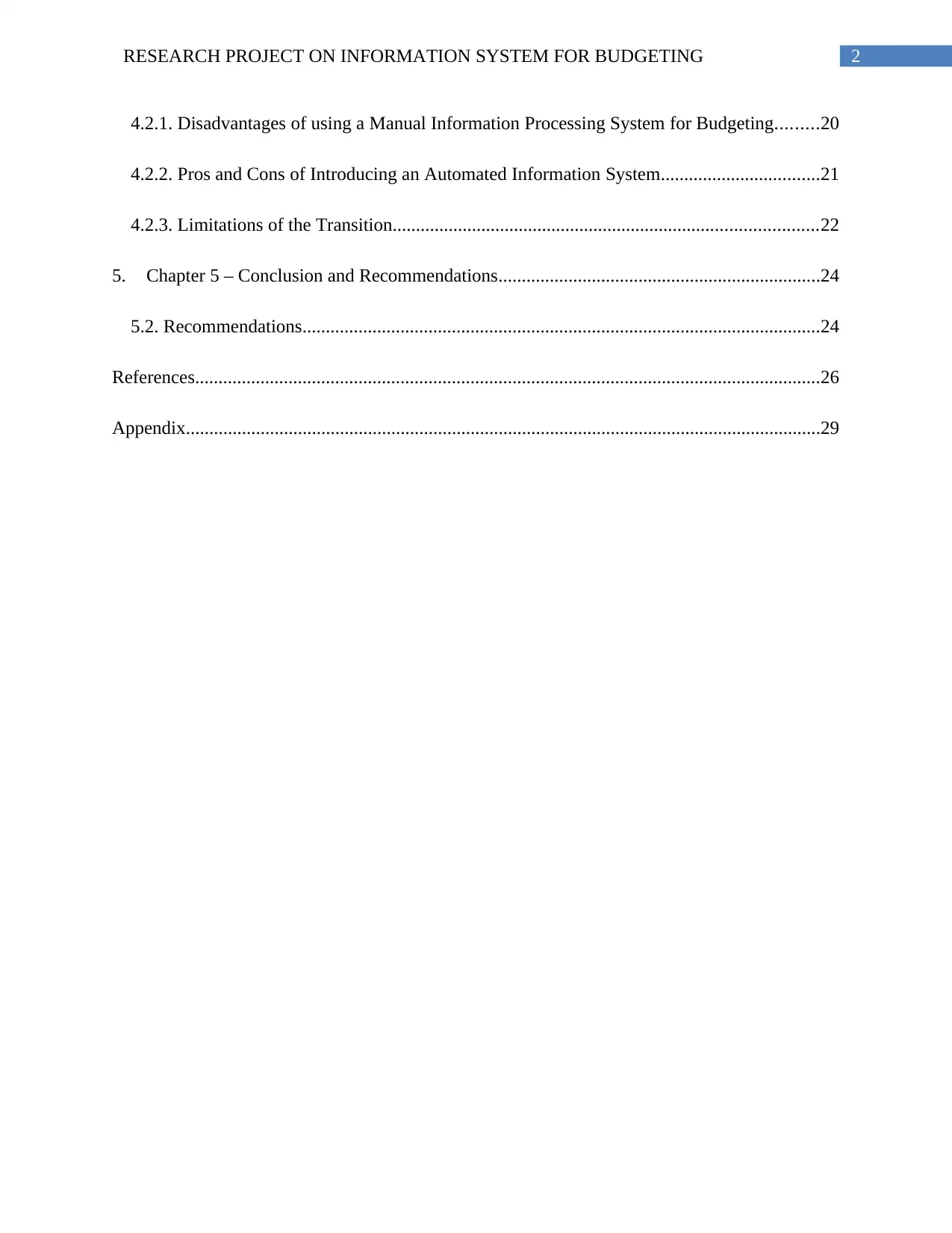
2RESEARCH PROJECT ON INFORMATION SYSTEM FOR BUDGETING
4.2.1. Disadvantages of using a Manual Information Processing System for Budgeting.........20
4.2.2. Pros and Cons of Introducing an Automated Information System..................................21
4.2.3. Limitations of the Transition...........................................................................................22
5. Chapter 5 – Conclusion and Recommendations.....................................................................24
5.2. Recommendations...............................................................................................................24
References......................................................................................................................................26
Appendix........................................................................................................................................29
4.2.1. Disadvantages of using a Manual Information Processing System for Budgeting.........20
4.2.2. Pros and Cons of Introducing an Automated Information System..................................21
4.2.3. Limitations of the Transition...........................................................................................22
5. Chapter 5 – Conclusion and Recommendations.....................................................................24
5.2. Recommendations...............................................................................................................24
References......................................................................................................................................26
Appendix........................................................................................................................................29
You're viewing a preview
Unlock full access by subscribing today!
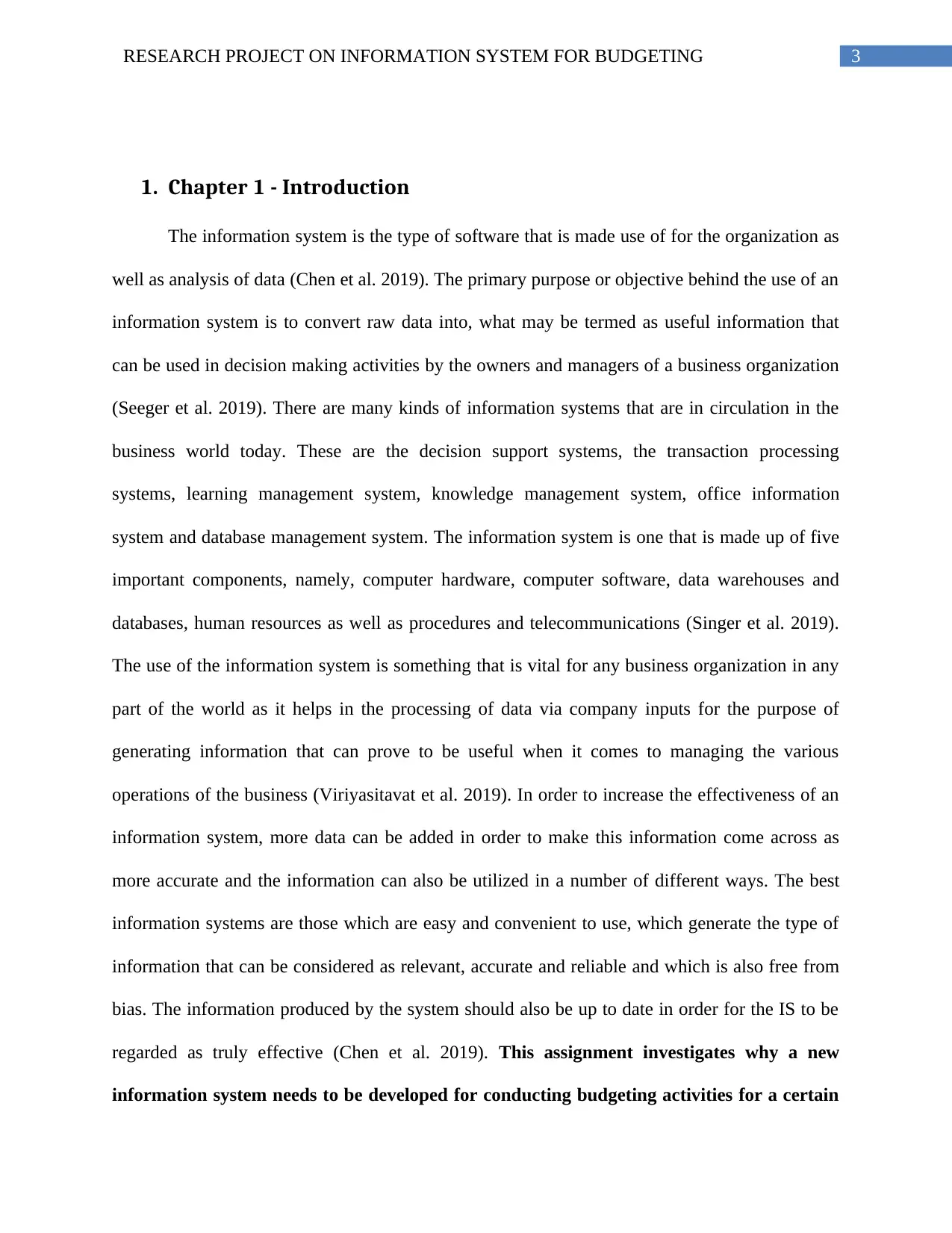
3RESEARCH PROJECT ON INFORMATION SYSTEM FOR BUDGETING
1. Chapter 1 - Introduction
The information system is the type of software that is made use of for the organization as
well as analysis of data (Chen et al. 2019). The primary purpose or objective behind the use of an
information system is to convert raw data into, what may be termed as useful information that
can be used in decision making activities by the owners and managers of a business organization
(Seeger et al. 2019). There are many kinds of information systems that are in circulation in the
business world today. These are the decision support systems, the transaction processing
systems, learning management system, knowledge management system, office information
system and database management system. The information system is one that is made up of five
important components, namely, computer hardware, computer software, data warehouses and
databases, human resources as well as procedures and telecommunications (Singer et al. 2019).
The use of the information system is something that is vital for any business organization in any
part of the world as it helps in the processing of data via company inputs for the purpose of
generating information that can prove to be useful when it comes to managing the various
operations of the business (Viriyasitavat et al. 2019). In order to increase the effectiveness of an
information system, more data can be added in order to make this information come across as
more accurate and the information can also be utilized in a number of different ways. The best
information systems are those which are easy and convenient to use, which generate the type of
information that can be considered as relevant, accurate and reliable and which is also free from
bias. The information produced by the system should also be up to date in order for the IS to be
regarded as truly effective (Chen et al. 2019). This assignment investigates why a new
information system needs to be developed for conducting budgeting activities for a certain
1. Chapter 1 - Introduction
The information system is the type of software that is made use of for the organization as
well as analysis of data (Chen et al. 2019). The primary purpose or objective behind the use of an
information system is to convert raw data into, what may be termed as useful information that
can be used in decision making activities by the owners and managers of a business organization
(Seeger et al. 2019). There are many kinds of information systems that are in circulation in the
business world today. These are the decision support systems, the transaction processing
systems, learning management system, knowledge management system, office information
system and database management system. The information system is one that is made up of five
important components, namely, computer hardware, computer software, data warehouses and
databases, human resources as well as procedures and telecommunications (Singer et al. 2019).
The use of the information system is something that is vital for any business organization in any
part of the world as it helps in the processing of data via company inputs for the purpose of
generating information that can prove to be useful when it comes to managing the various
operations of the business (Viriyasitavat et al. 2019). In order to increase the effectiveness of an
information system, more data can be added in order to make this information come across as
more accurate and the information can also be utilized in a number of different ways. The best
information systems are those which are easy and convenient to use, which generate the type of
information that can be considered as relevant, accurate and reliable and which is also free from
bias. The information produced by the system should also be up to date in order for the IS to be
regarded as truly effective (Chen et al. 2019). This assignment investigates why a new
information system needs to be developed for conducting budgeting activities for a certain
Paraphrase This Document
Need a fresh take? Get an instant paraphrase of this document with our AI Paraphraser
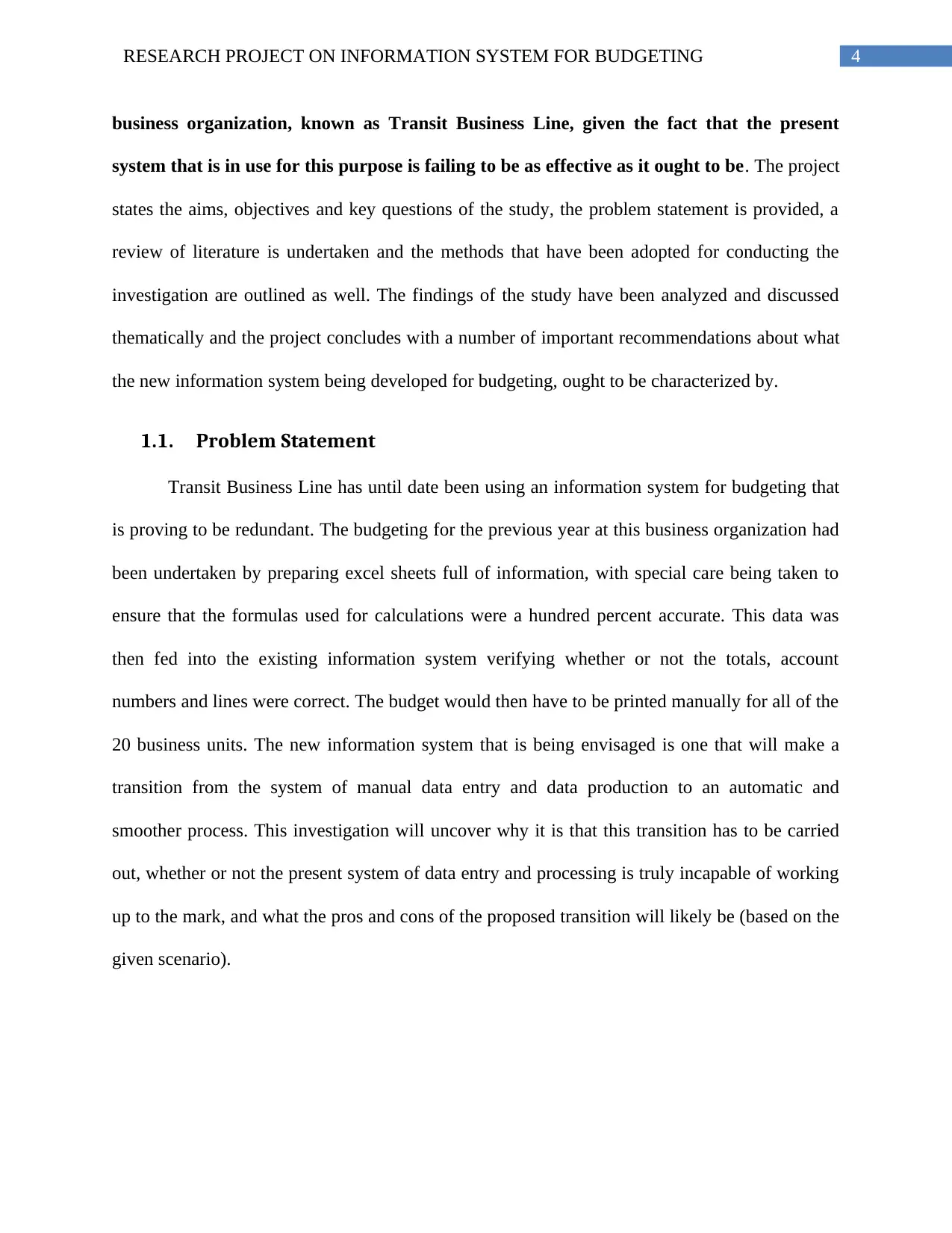
4RESEARCH PROJECT ON INFORMATION SYSTEM FOR BUDGETING
business organization, known as Transit Business Line, given the fact that the present
system that is in use for this purpose is failing to be as effective as it ought to be. The project
states the aims, objectives and key questions of the study, the problem statement is provided, a
review of literature is undertaken and the methods that have been adopted for conducting the
investigation are outlined as well. The findings of the study have been analyzed and discussed
thematically and the project concludes with a number of important recommendations about what
the new information system being developed for budgeting, ought to be characterized by.
1.1. Problem Statement
Transit Business Line has until date been using an information system for budgeting that
is proving to be redundant. The budgeting for the previous year at this business organization had
been undertaken by preparing excel sheets full of information, with special care being taken to
ensure that the formulas used for calculations were a hundred percent accurate. This data was
then fed into the existing information system verifying whether or not the totals, account
numbers and lines were correct. The budget would then have to be printed manually for all of the
20 business units. The new information system that is being envisaged is one that will make a
transition from the system of manual data entry and data production to an automatic and
smoother process. This investigation will uncover why it is that this transition has to be carried
out, whether or not the present system of data entry and processing is truly incapable of working
up to the mark, and what the pros and cons of the proposed transition will likely be (based on the
given scenario).
business organization, known as Transit Business Line, given the fact that the present
system that is in use for this purpose is failing to be as effective as it ought to be. The project
states the aims, objectives and key questions of the study, the problem statement is provided, a
review of literature is undertaken and the methods that have been adopted for conducting the
investigation are outlined as well. The findings of the study have been analyzed and discussed
thematically and the project concludes with a number of important recommendations about what
the new information system being developed for budgeting, ought to be characterized by.
1.1. Problem Statement
Transit Business Line has until date been using an information system for budgeting that
is proving to be redundant. The budgeting for the previous year at this business organization had
been undertaken by preparing excel sheets full of information, with special care being taken to
ensure that the formulas used for calculations were a hundred percent accurate. This data was
then fed into the existing information system verifying whether or not the totals, account
numbers and lines were correct. The budget would then have to be printed manually for all of the
20 business units. The new information system that is being envisaged is one that will make a
transition from the system of manual data entry and data production to an automatic and
smoother process. This investigation will uncover why it is that this transition has to be carried
out, whether or not the present system of data entry and processing is truly incapable of working
up to the mark, and what the pros and cons of the proposed transition will likely be (based on the
given scenario).
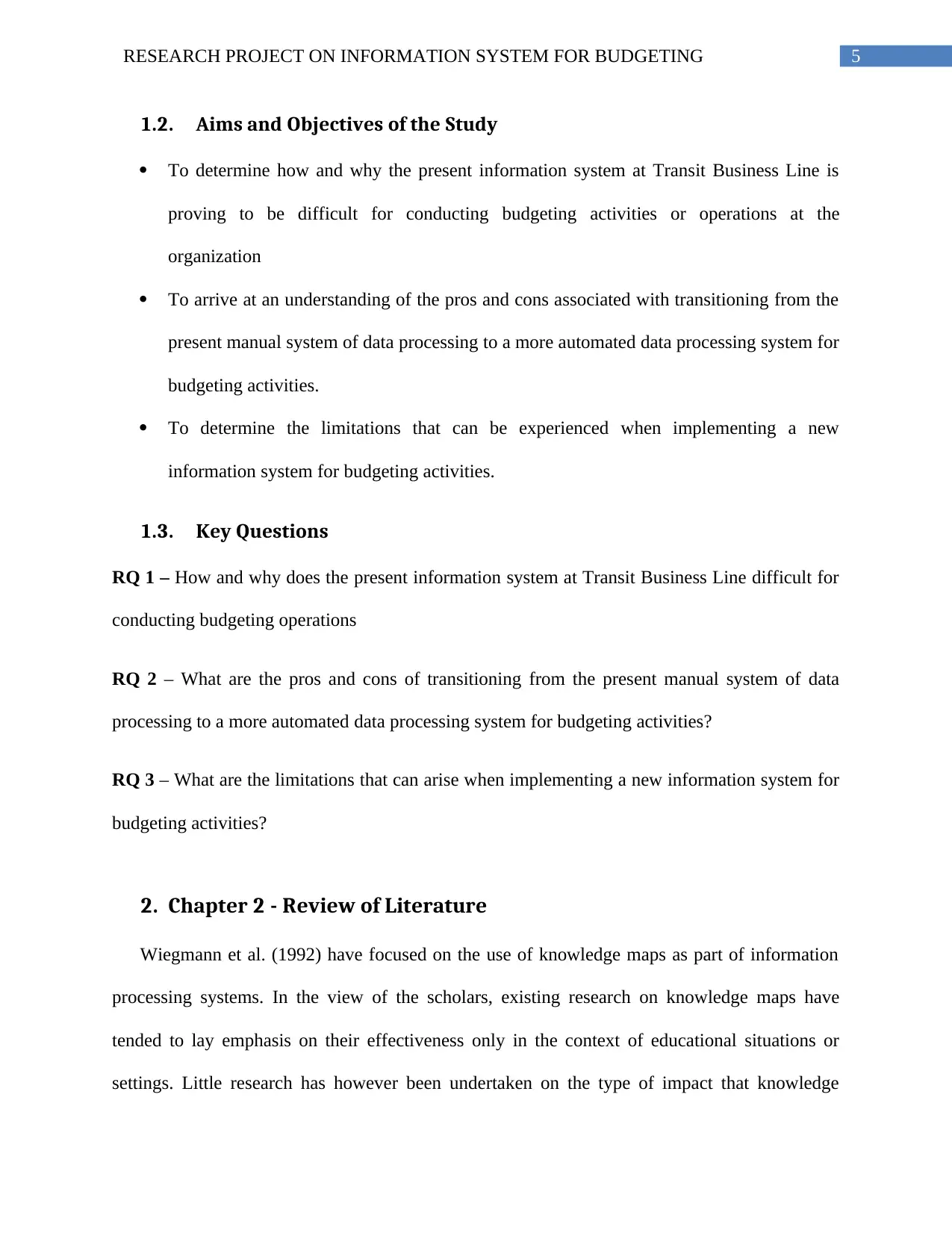
5RESEARCH PROJECT ON INFORMATION SYSTEM FOR BUDGETING
1.2. Aims and Objectives of the Study
To determine how and why the present information system at Transit Business Line is
proving to be difficult for conducting budgeting activities or operations at the
organization
To arrive at an understanding of the pros and cons associated with transitioning from the
present manual system of data processing to a more automated data processing system for
budgeting activities.
To determine the limitations that can be experienced when implementing a new
information system for budgeting activities.
1.3. Key Questions
RQ 1 – How and why does the present information system at Transit Business Line difficult for
conducting budgeting operations
RQ 2 – What are the pros and cons of transitioning from the present manual system of data
processing to a more automated data processing system for budgeting activities?
RQ 3 – What are the limitations that can arise when implementing a new information system for
budgeting activities?
2. Chapter 2 - Review of Literature
Wiegmann et al. (1992) have focused on the use of knowledge maps as part of information
processing systems. In the view of the scholars, existing research on knowledge maps have
tended to lay emphasis on their effectiveness only in the context of educational situations or
settings. Little research has however been undertaken on the type of impact that knowledge
1.2. Aims and Objectives of the Study
To determine how and why the present information system at Transit Business Line is
proving to be difficult for conducting budgeting activities or operations at the
organization
To arrive at an understanding of the pros and cons associated with transitioning from the
present manual system of data processing to a more automated data processing system for
budgeting activities.
To determine the limitations that can be experienced when implementing a new
information system for budgeting activities.
1.3. Key Questions
RQ 1 – How and why does the present information system at Transit Business Line difficult for
conducting budgeting operations
RQ 2 – What are the pros and cons of transitioning from the present manual system of data
processing to a more automated data processing system for budgeting activities?
RQ 3 – What are the limitations that can arise when implementing a new information system for
budgeting activities?
2. Chapter 2 - Review of Literature
Wiegmann et al. (1992) have focused on the use of knowledge maps as part of information
processing systems. In the view of the scholars, existing research on knowledge maps have
tended to lay emphasis on their effectiveness only in the context of educational situations or
settings. Little research has however been undertaken on the type of impact that knowledge
You're viewing a preview
Unlock full access by subscribing today!
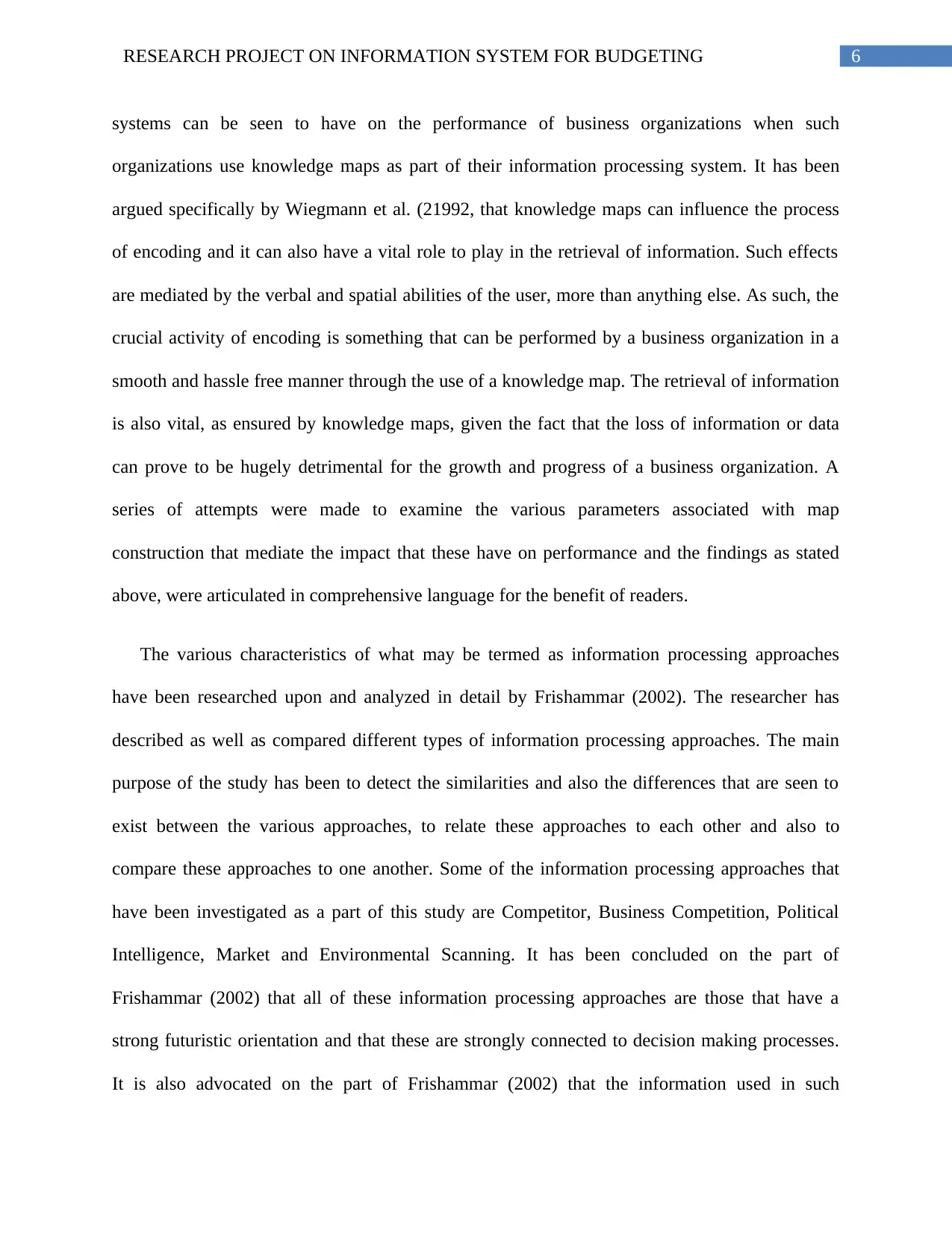
6RESEARCH PROJECT ON INFORMATION SYSTEM FOR BUDGETING
systems can be seen to have on the performance of business organizations when such
organizations use knowledge maps as part of their information processing system. It has been
argued specifically by Wiegmann et al. (21992, that knowledge maps can influence the process
of encoding and it can also have a vital role to play in the retrieval of information. Such effects
are mediated by the verbal and spatial abilities of the user, more than anything else. As such, the
crucial activity of encoding is something that can be performed by a business organization in a
smooth and hassle free manner through the use of a knowledge map. The retrieval of information
is also vital, as ensured by knowledge maps, given the fact that the loss of information or data
can prove to be hugely detrimental for the growth and progress of a business organization. A
series of attempts were made to examine the various parameters associated with map
construction that mediate the impact that these have on performance and the findings as stated
above, were articulated in comprehensive language for the benefit of readers.
The various characteristics of what may be termed as information processing approaches
have been researched upon and analyzed in detail by Frishammar (2002). The researcher has
described as well as compared different types of information processing approaches. The main
purpose of the study has been to detect the similarities and also the differences that are seen to
exist between the various approaches, to relate these approaches to each other and also to
compare these approaches to one another. Some of the information processing approaches that
have been investigated as a part of this study are Competitor, Business Competition, Political
Intelligence, Market and Environmental Scanning. It has been concluded on the part of
Frishammar (2002) that all of these information processing approaches are those that have a
strong futuristic orientation and that these are strongly connected to decision making processes.
It is also advocated on the part of Frishammar (2002) that the information used in such
systems can be seen to have on the performance of business organizations when such
organizations use knowledge maps as part of their information processing system. It has been
argued specifically by Wiegmann et al. (21992, that knowledge maps can influence the process
of encoding and it can also have a vital role to play in the retrieval of information. Such effects
are mediated by the verbal and spatial abilities of the user, more than anything else. As such, the
crucial activity of encoding is something that can be performed by a business organization in a
smooth and hassle free manner through the use of a knowledge map. The retrieval of information
is also vital, as ensured by knowledge maps, given the fact that the loss of information or data
can prove to be hugely detrimental for the growth and progress of a business organization. A
series of attempts were made to examine the various parameters associated with map
construction that mediate the impact that these have on performance and the findings as stated
above, were articulated in comprehensive language for the benefit of readers.
The various characteristics of what may be termed as information processing approaches
have been researched upon and analyzed in detail by Frishammar (2002). The researcher has
described as well as compared different types of information processing approaches. The main
purpose of the study has been to detect the similarities and also the differences that are seen to
exist between the various approaches, to relate these approaches to each other and also to
compare these approaches to one another. Some of the information processing approaches that
have been investigated as a part of this study are Competitor, Business Competition, Political
Intelligence, Market and Environmental Scanning. It has been concluded on the part of
Frishammar (2002) that all of these information processing approaches are those that have a
strong futuristic orientation and that these are strongly connected to decision making processes.
It is also advocated on the part of Frishammar (2002) that the information used in such
Paraphrase This Document
Need a fresh take? Get an instant paraphrase of this document with our AI Paraphraser
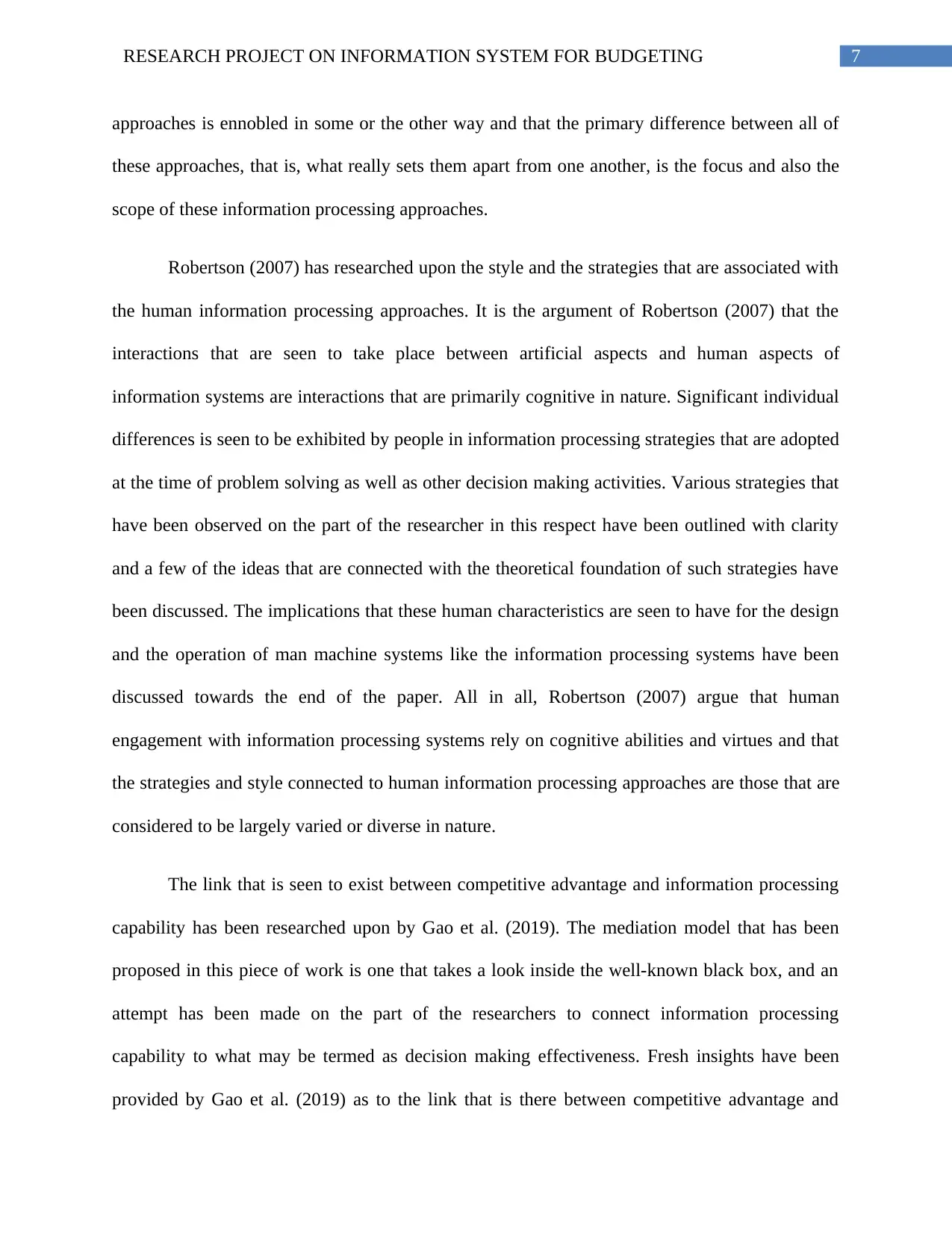
7RESEARCH PROJECT ON INFORMATION SYSTEM FOR BUDGETING
approaches is ennobled in some or the other way and that the primary difference between all of
these approaches, that is, what really sets them apart from one another, is the focus and also the
scope of these information processing approaches.
Robertson (2007) has researched upon the style and the strategies that are associated with
the human information processing approaches. It is the argument of Robertson (2007) that the
interactions that are seen to take place between artificial aspects and human aspects of
information systems are interactions that are primarily cognitive in nature. Significant individual
differences is seen to be exhibited by people in information processing strategies that are adopted
at the time of problem solving as well as other decision making activities. Various strategies that
have been observed on the part of the researcher in this respect have been outlined with clarity
and a few of the ideas that are connected with the theoretical foundation of such strategies have
been discussed. The implications that these human characteristics are seen to have for the design
and the operation of man machine systems like the information processing systems have been
discussed towards the end of the paper. All in all, Robertson (2007) argue that human
engagement with information processing systems rely on cognitive abilities and virtues and that
the strategies and style connected to human information processing approaches are those that are
considered to be largely varied or diverse in nature.
The link that is seen to exist between competitive advantage and information processing
capability has been researched upon by Gao et al. (2019). The mediation model that has been
proposed in this piece of work is one that takes a look inside the well-known black box, and an
attempt has been made on the part of the researchers to connect information processing
capability to what may be termed as decision making effectiveness. Fresh insights have been
provided by Gao et al. (2019) as to the link that is there between competitive advantage and
approaches is ennobled in some or the other way and that the primary difference between all of
these approaches, that is, what really sets them apart from one another, is the focus and also the
scope of these information processing approaches.
Robertson (2007) has researched upon the style and the strategies that are associated with
the human information processing approaches. It is the argument of Robertson (2007) that the
interactions that are seen to take place between artificial aspects and human aspects of
information systems are interactions that are primarily cognitive in nature. Significant individual
differences is seen to be exhibited by people in information processing strategies that are adopted
at the time of problem solving as well as other decision making activities. Various strategies that
have been observed on the part of the researcher in this respect have been outlined with clarity
and a few of the ideas that are connected with the theoretical foundation of such strategies have
been discussed. The implications that these human characteristics are seen to have for the design
and the operation of man machine systems like the information processing systems have been
discussed towards the end of the paper. All in all, Robertson (2007) argue that human
engagement with information processing systems rely on cognitive abilities and virtues and that
the strategies and style connected to human information processing approaches are those that are
considered to be largely varied or diverse in nature.
The link that is seen to exist between competitive advantage and information processing
capability has been researched upon by Gao et al. (2019). The mediation model that has been
proposed in this piece of work is one that takes a look inside the well-known black box, and an
attempt has been made on the part of the researchers to connect information processing
capability to what may be termed as decision making effectiveness. Fresh insights have been
provided by Gao et al. (2019) as to the link that is there between competitive advantage and
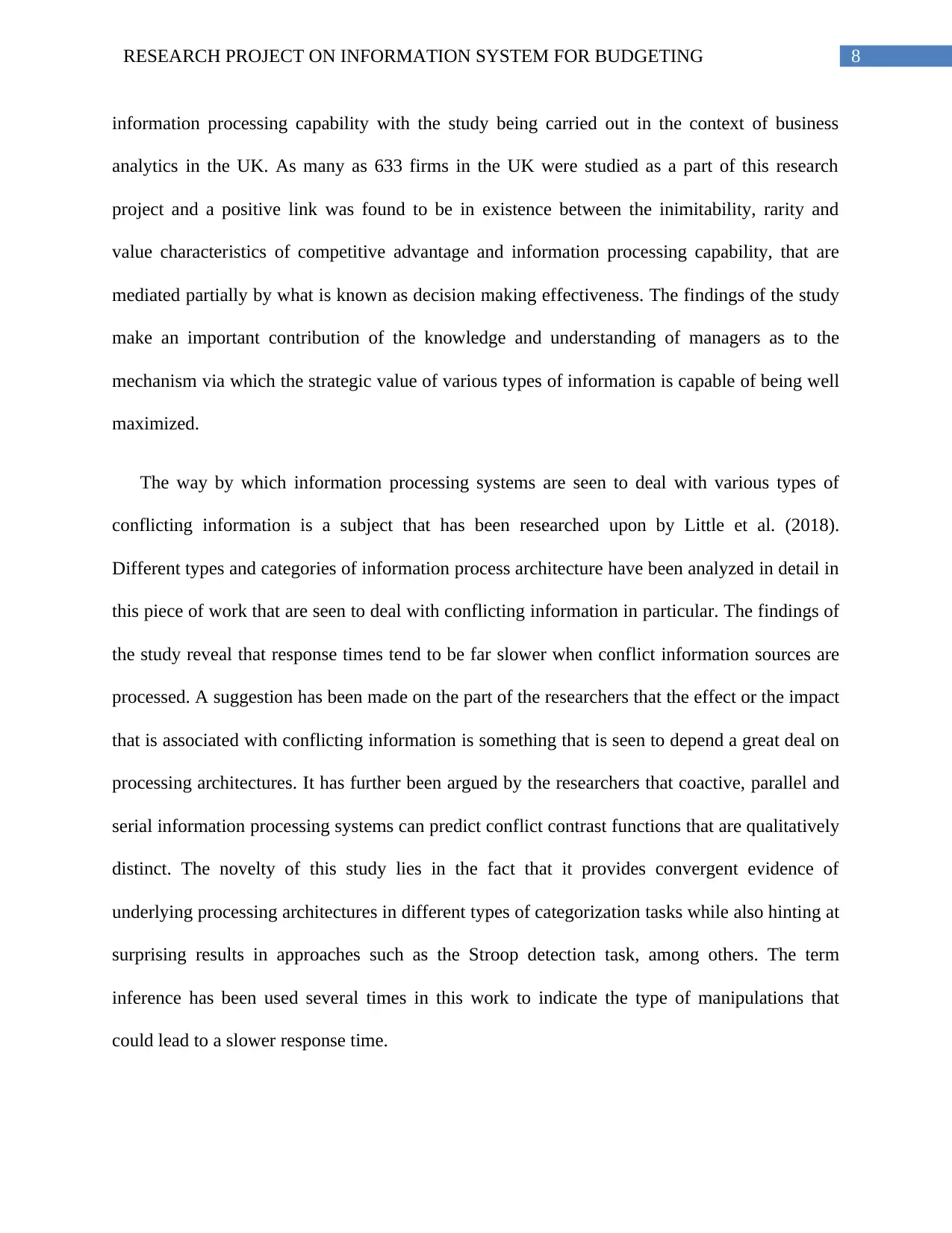
8RESEARCH PROJECT ON INFORMATION SYSTEM FOR BUDGETING
information processing capability with the study being carried out in the context of business
analytics in the UK. As many as 633 firms in the UK were studied as a part of this research
project and a positive link was found to be in existence between the inimitability, rarity and
value characteristics of competitive advantage and information processing capability, that are
mediated partially by what is known as decision making effectiveness. The findings of the study
make an important contribution of the knowledge and understanding of managers as to the
mechanism via which the strategic value of various types of information is capable of being well
maximized.
The way by which information processing systems are seen to deal with various types of
conflicting information is a subject that has been researched upon by Little et al. (2018).
Different types and categories of information process architecture have been analyzed in detail in
this piece of work that are seen to deal with conflicting information in particular. The findings of
the study reveal that response times tend to be far slower when conflict information sources are
processed. A suggestion has been made on the part of the researchers that the effect or the impact
that is associated with conflicting information is something that is seen to depend a great deal on
processing architectures. It has further been argued by the researchers that coactive, parallel and
serial information processing systems can predict conflict contrast functions that are qualitatively
distinct. The novelty of this study lies in the fact that it provides convergent evidence of
underlying processing architectures in different types of categorization tasks while also hinting at
surprising results in approaches such as the Stroop detection task, among others. The term
inference has been used several times in this work to indicate the type of manipulations that
could lead to a slower response time.
information processing capability with the study being carried out in the context of business
analytics in the UK. As many as 633 firms in the UK were studied as a part of this research
project and a positive link was found to be in existence between the inimitability, rarity and
value characteristics of competitive advantage and information processing capability, that are
mediated partially by what is known as decision making effectiveness. The findings of the study
make an important contribution of the knowledge and understanding of managers as to the
mechanism via which the strategic value of various types of information is capable of being well
maximized.
The way by which information processing systems are seen to deal with various types of
conflicting information is a subject that has been researched upon by Little et al. (2018).
Different types and categories of information process architecture have been analyzed in detail in
this piece of work that are seen to deal with conflicting information in particular. The findings of
the study reveal that response times tend to be far slower when conflict information sources are
processed. A suggestion has been made on the part of the researchers that the effect or the impact
that is associated with conflicting information is something that is seen to depend a great deal on
processing architectures. It has further been argued by the researchers that coactive, parallel and
serial information processing systems can predict conflict contrast functions that are qualitatively
distinct. The novelty of this study lies in the fact that it provides convergent evidence of
underlying processing architectures in different types of categorization tasks while also hinting at
surprising results in approaches such as the Stroop detection task, among others. The term
inference has been used several times in this work to indicate the type of manipulations that
could lead to a slower response time.
You're viewing a preview
Unlock full access by subscribing today!
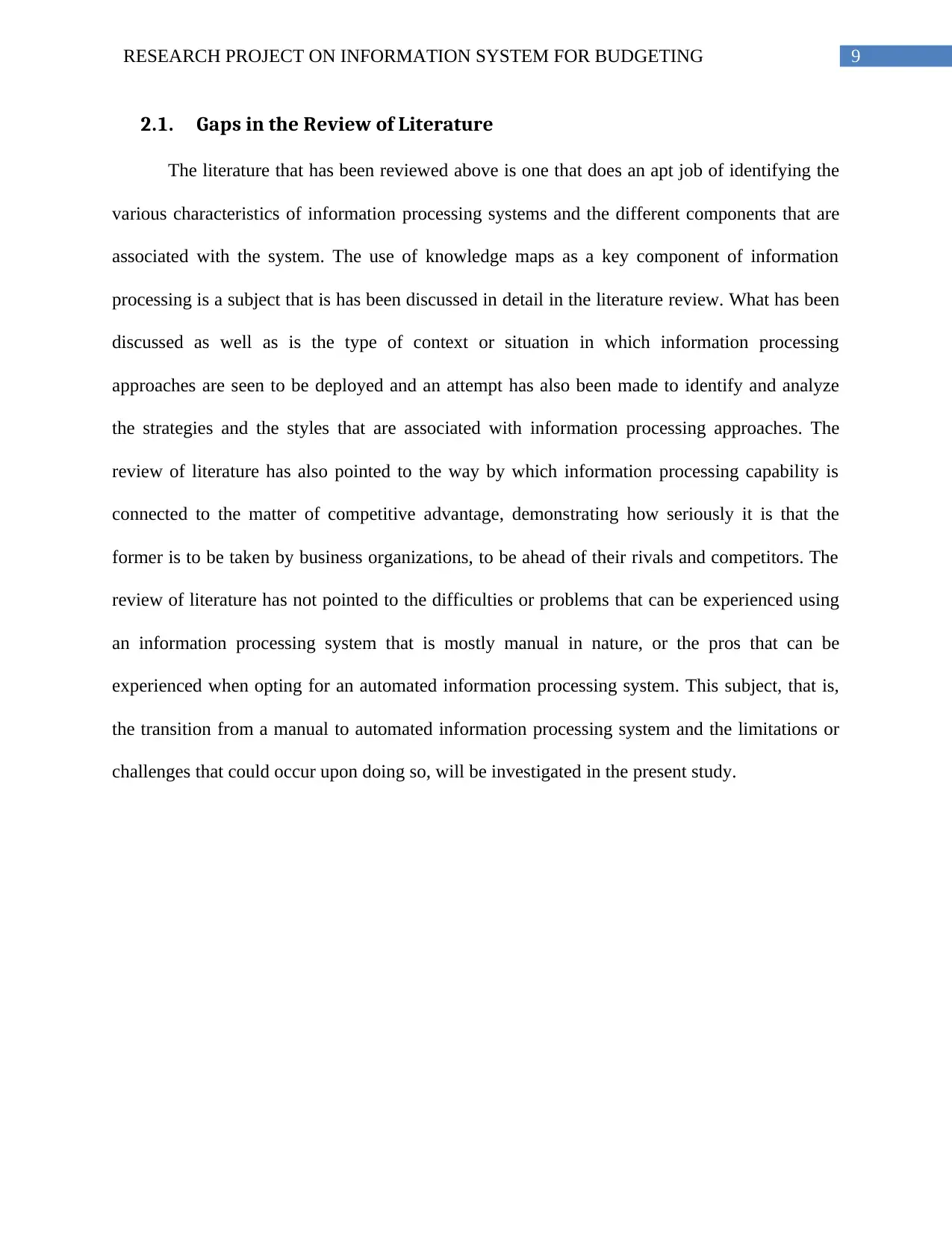
9RESEARCH PROJECT ON INFORMATION SYSTEM FOR BUDGETING
2.1. Gaps in the Review of Literature
The literature that has been reviewed above is one that does an apt job of identifying the
various characteristics of information processing systems and the different components that are
associated with the system. The use of knowledge maps as a key component of information
processing is a subject that is has been discussed in detail in the literature review. What has been
discussed as well as is the type of context or situation in which information processing
approaches are seen to be deployed and an attempt has also been made to identify and analyze
the strategies and the styles that are associated with information processing approaches. The
review of literature has also pointed to the way by which information processing capability is
connected to the matter of competitive advantage, demonstrating how seriously it is that the
former is to be taken by business organizations, to be ahead of their rivals and competitors. The
review of literature has not pointed to the difficulties or problems that can be experienced using
an information processing system that is mostly manual in nature, or the pros that can be
experienced when opting for an automated information processing system. This subject, that is,
the transition from a manual to automated information processing system and the limitations or
challenges that could occur upon doing so, will be investigated in the present study.
2.1. Gaps in the Review of Literature
The literature that has been reviewed above is one that does an apt job of identifying the
various characteristics of information processing systems and the different components that are
associated with the system. The use of knowledge maps as a key component of information
processing is a subject that is has been discussed in detail in the literature review. What has been
discussed as well as is the type of context or situation in which information processing
approaches are seen to be deployed and an attempt has also been made to identify and analyze
the strategies and the styles that are associated with information processing approaches. The
review of literature has also pointed to the way by which information processing capability is
connected to the matter of competitive advantage, demonstrating how seriously it is that the
former is to be taken by business organizations, to be ahead of their rivals and competitors. The
review of literature has not pointed to the difficulties or problems that can be experienced using
an information processing system that is mostly manual in nature, or the pros that can be
experienced when opting for an automated information processing system. This subject, that is,
the transition from a manual to automated information processing system and the limitations or
challenges that could occur upon doing so, will be investigated in the present study.
Paraphrase This Document
Need a fresh take? Get an instant paraphrase of this document with our AI Paraphraser
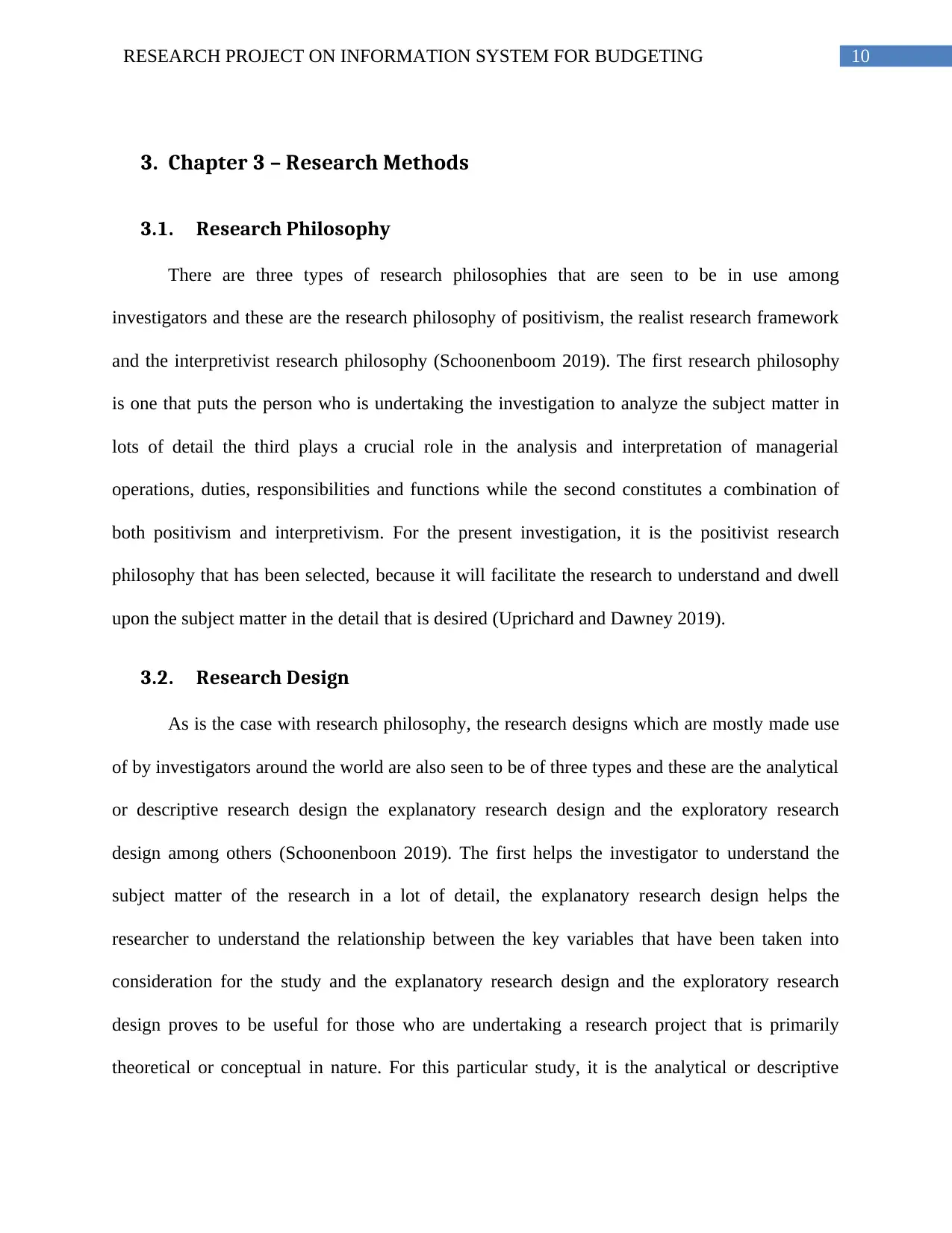
10RESEARCH PROJECT ON INFORMATION SYSTEM FOR BUDGETING
3. Chapter 3 – Research Methods
3.1. Research Philosophy
There are three types of research philosophies that are seen to be in use among
investigators and these are the research philosophy of positivism, the realist research framework
and the interpretivist research philosophy (Schoonenboom 2019). The first research philosophy
is one that puts the person who is undertaking the investigation to analyze the subject matter in
lots of detail the third plays a crucial role in the analysis and interpretation of managerial
operations, duties, responsibilities and functions while the second constitutes a combination of
both positivism and interpretivism. For the present investigation, it is the positivist research
philosophy that has been selected, because it will facilitate the research to understand and dwell
upon the subject matter in the detail that is desired (Uprichard and Dawney 2019).
3.2. Research Design
As is the case with research philosophy, the research designs which are mostly made use
of by investigators around the world are also seen to be of three types and these are the analytical
or descriptive research design the explanatory research design and the exploratory research
design among others (Schoonenboon 2019). The first helps the investigator to understand the
subject matter of the research in a lot of detail, the explanatory research design helps the
researcher to understand the relationship between the key variables that have been taken into
consideration for the study and the explanatory research design and the exploratory research
design proves to be useful for those who are undertaking a research project that is primarily
theoretical or conceptual in nature. For this particular study, it is the analytical or descriptive
3. Chapter 3 – Research Methods
3.1. Research Philosophy
There are three types of research philosophies that are seen to be in use among
investigators and these are the research philosophy of positivism, the realist research framework
and the interpretivist research philosophy (Schoonenboom 2019). The first research philosophy
is one that puts the person who is undertaking the investigation to analyze the subject matter in
lots of detail the third plays a crucial role in the analysis and interpretation of managerial
operations, duties, responsibilities and functions while the second constitutes a combination of
both positivism and interpretivism. For the present investigation, it is the positivist research
philosophy that has been selected, because it will facilitate the research to understand and dwell
upon the subject matter in the detail that is desired (Uprichard and Dawney 2019).
3.2. Research Design
As is the case with research philosophy, the research designs which are mostly made use
of by investigators around the world are also seen to be of three types and these are the analytical
or descriptive research design the explanatory research design and the exploratory research
design among others (Schoonenboon 2019). The first helps the investigator to understand the
subject matter of the research in a lot of detail, the explanatory research design helps the
researcher to understand the relationship between the key variables that have been taken into
consideration for the study and the explanatory research design and the exploratory research
design proves to be useful for those who are undertaking a research project that is primarily
theoretical or conceptual in nature. For this particular study, it is the analytical or descriptive
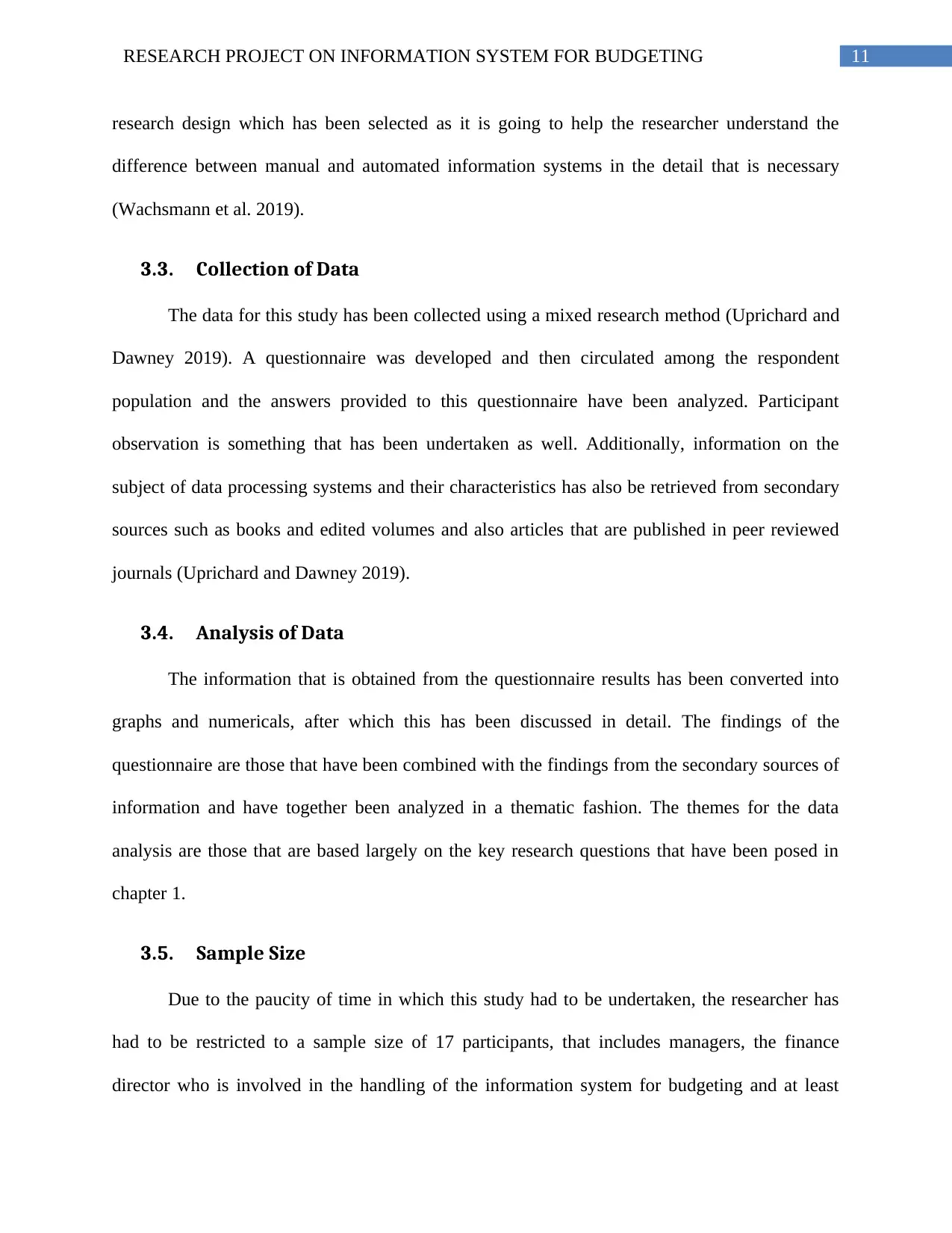
11RESEARCH PROJECT ON INFORMATION SYSTEM FOR BUDGETING
research design which has been selected as it is going to help the researcher understand the
difference between manual and automated information systems in the detail that is necessary
(Wachsmann et al. 2019).
3.3. Collection of Data
The data for this study has been collected using a mixed research method (Uprichard and
Dawney 2019). A questionnaire was developed and then circulated among the respondent
population and the answers provided to this questionnaire have been analyzed. Participant
observation is something that has been undertaken as well. Additionally, information on the
subject of data processing systems and their characteristics has also be retrieved from secondary
sources such as books and edited volumes and also articles that are published in peer reviewed
journals (Uprichard and Dawney 2019).
3.4. Analysis of Data
The information that is obtained from the questionnaire results has been converted into
graphs and numericals, after which this has been discussed in detail. The findings of the
questionnaire are those that have been combined with the findings from the secondary sources of
information and have together been analyzed in a thematic fashion. The themes for the data
analysis are those that are based largely on the key research questions that have been posed in
chapter 1.
3.5. Sample Size
Due to the paucity of time in which this study had to be undertaken, the researcher has
had to be restricted to a sample size of 17 participants, that includes managers, the finance
director who is involved in the handling of the information system for budgeting and at least
research design which has been selected as it is going to help the researcher understand the
difference between manual and automated information systems in the detail that is necessary
(Wachsmann et al. 2019).
3.3. Collection of Data
The data for this study has been collected using a mixed research method (Uprichard and
Dawney 2019). A questionnaire was developed and then circulated among the respondent
population and the answers provided to this questionnaire have been analyzed. Participant
observation is something that has been undertaken as well. Additionally, information on the
subject of data processing systems and their characteristics has also be retrieved from secondary
sources such as books and edited volumes and also articles that are published in peer reviewed
journals (Uprichard and Dawney 2019).
3.4. Analysis of Data
The information that is obtained from the questionnaire results has been converted into
graphs and numericals, after which this has been discussed in detail. The findings of the
questionnaire are those that have been combined with the findings from the secondary sources of
information and have together been analyzed in a thematic fashion. The themes for the data
analysis are those that are based largely on the key research questions that have been posed in
chapter 1.
3.5. Sample Size
Due to the paucity of time in which this study had to be undertaken, the researcher has
had to be restricted to a sample size of 17 participants, that includes managers, the finance
director who is involved in the handling of the information system for budgeting and at least
You're viewing a preview
Unlock full access by subscribing today!
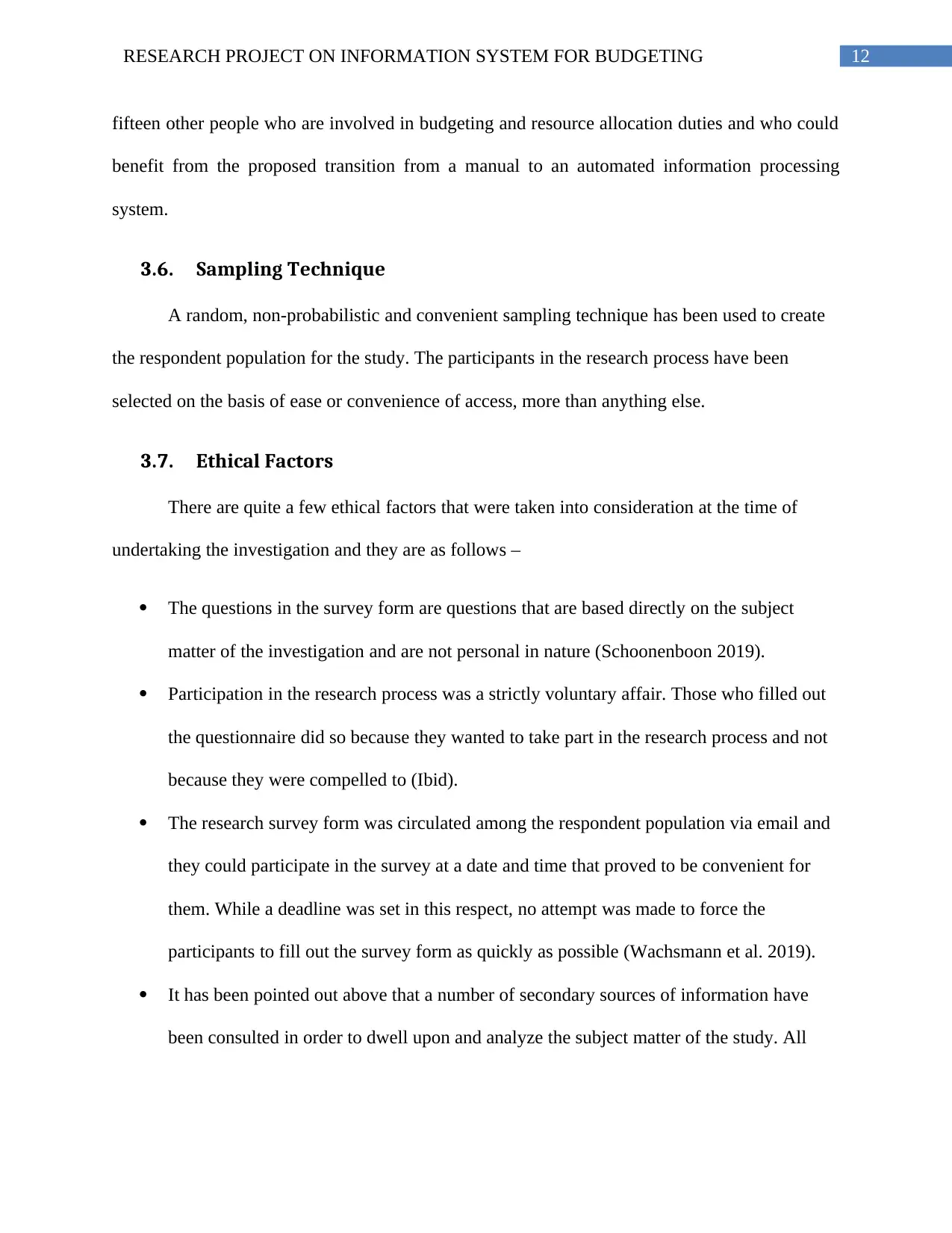
12RESEARCH PROJECT ON INFORMATION SYSTEM FOR BUDGETING
fifteen other people who are involved in budgeting and resource allocation duties and who could
benefit from the proposed transition from a manual to an automated information processing
system.
3.6. Sampling Technique
A random, non-probabilistic and convenient sampling technique has been used to create
the respondent population for the study. The participants in the research process have been
selected on the basis of ease or convenience of access, more than anything else.
3.7. Ethical Factors
There are quite a few ethical factors that were taken into consideration at the time of
undertaking the investigation and they are as follows –
The questions in the survey form are questions that are based directly on the subject
matter of the investigation and are not personal in nature (Schoonenboon 2019).
Participation in the research process was a strictly voluntary affair. Those who filled out
the questionnaire did so because they wanted to take part in the research process and not
because they were compelled to (Ibid).
The research survey form was circulated among the respondent population via email and
they could participate in the survey at a date and time that proved to be convenient for
them. While a deadline was set in this respect, no attempt was made to force the
participants to fill out the survey form as quickly as possible (Wachsmann et al. 2019).
It has been pointed out above that a number of secondary sources of information have
been consulted in order to dwell upon and analyze the subject matter of the study. All
fifteen other people who are involved in budgeting and resource allocation duties and who could
benefit from the proposed transition from a manual to an automated information processing
system.
3.6. Sampling Technique
A random, non-probabilistic and convenient sampling technique has been used to create
the respondent population for the study. The participants in the research process have been
selected on the basis of ease or convenience of access, more than anything else.
3.7. Ethical Factors
There are quite a few ethical factors that were taken into consideration at the time of
undertaking the investigation and they are as follows –
The questions in the survey form are questions that are based directly on the subject
matter of the investigation and are not personal in nature (Schoonenboon 2019).
Participation in the research process was a strictly voluntary affair. Those who filled out
the questionnaire did so because they wanted to take part in the research process and not
because they were compelled to (Ibid).
The research survey form was circulated among the respondent population via email and
they could participate in the survey at a date and time that proved to be convenient for
them. While a deadline was set in this respect, no attempt was made to force the
participants to fill out the survey form as quickly as possible (Wachsmann et al. 2019).
It has been pointed out above that a number of secondary sources of information have
been consulted in order to dwell upon and analyze the subject matter of the study. All
Paraphrase This Document
Need a fresh take? Get an instant paraphrase of this document with our AI Paraphraser
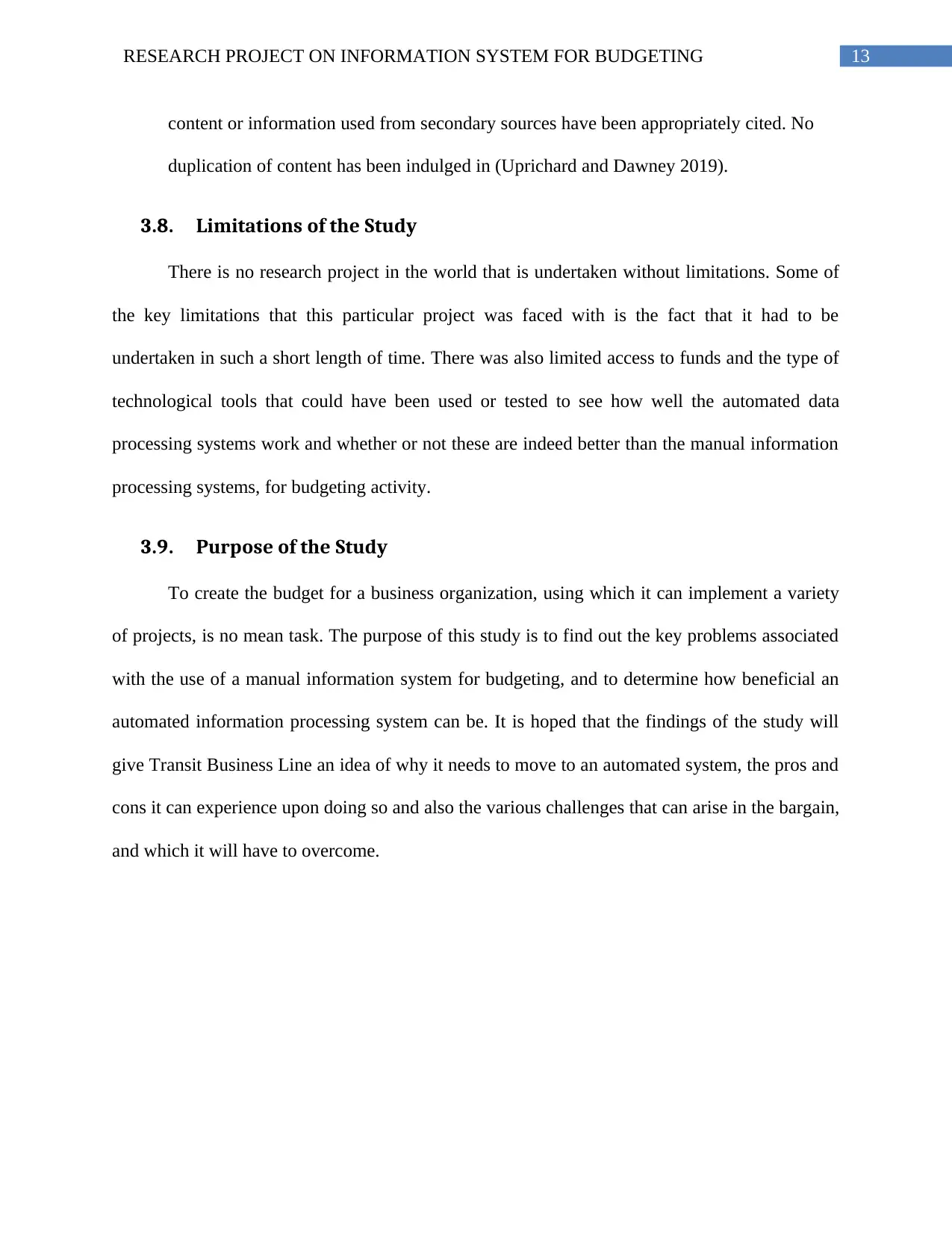
13RESEARCH PROJECT ON INFORMATION SYSTEM FOR BUDGETING
content or information used from secondary sources have been appropriately cited. No
duplication of content has been indulged in (Uprichard and Dawney 2019).
3.8. Limitations of the Study
There is no research project in the world that is undertaken without limitations. Some of
the key limitations that this particular project was faced with is the fact that it had to be
undertaken in such a short length of time. There was also limited access to funds and the type of
technological tools that could have been used or tested to see how well the automated data
processing systems work and whether or not these are indeed better than the manual information
processing systems, for budgeting activity.
3.9. Purpose of the Study
To create the budget for a business organization, using which it can implement a variety
of projects, is no mean task. The purpose of this study is to find out the key problems associated
with the use of a manual information system for budgeting, and to determine how beneficial an
automated information processing system can be. It is hoped that the findings of the study will
give Transit Business Line an idea of why it needs to move to an automated system, the pros and
cons it can experience upon doing so and also the various challenges that can arise in the bargain,
and which it will have to overcome.
content or information used from secondary sources have been appropriately cited. No
duplication of content has been indulged in (Uprichard and Dawney 2019).
3.8. Limitations of the Study
There is no research project in the world that is undertaken without limitations. Some of
the key limitations that this particular project was faced with is the fact that it had to be
undertaken in such a short length of time. There was also limited access to funds and the type of
technological tools that could have been used or tested to see how well the automated data
processing systems work and whether or not these are indeed better than the manual information
processing systems, for budgeting activity.
3.9. Purpose of the Study
To create the budget for a business organization, using which it can implement a variety
of projects, is no mean task. The purpose of this study is to find out the key problems associated
with the use of a manual information system for budgeting, and to determine how beneficial an
automated information processing system can be. It is hoped that the findings of the study will
give Transit Business Line an idea of why it needs to move to an automated system, the pros and
cons it can experience upon doing so and also the various challenges that can arise in the bargain,
and which it will have to overcome.
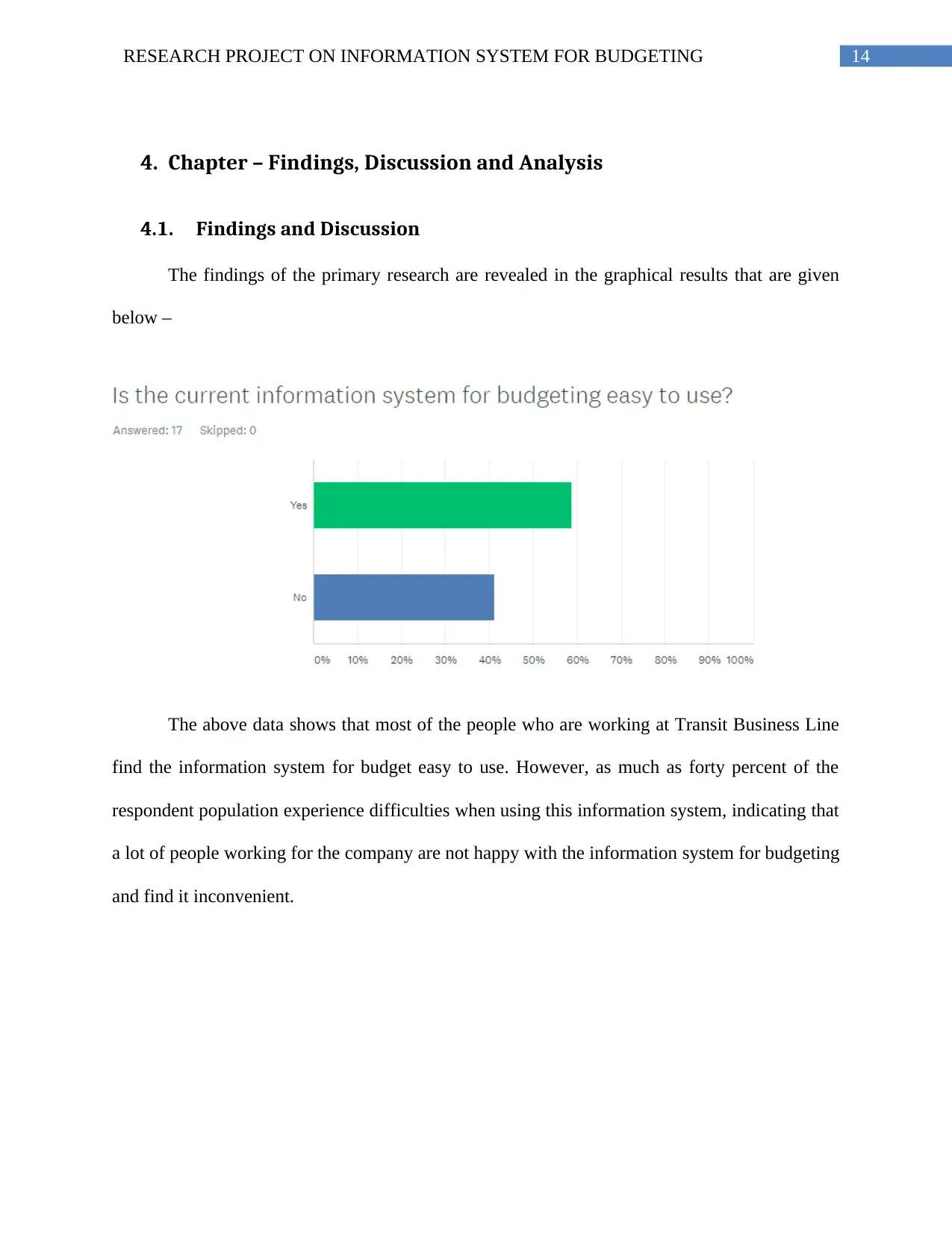
14RESEARCH PROJECT ON INFORMATION SYSTEM FOR BUDGETING
4. Chapter – Findings, Discussion and Analysis
4.1. Findings and Discussion
The findings of the primary research are revealed in the graphical results that are given
below –
The above data shows that most of the people who are working at Transit Business Line
find the information system for budget easy to use. However, as much as forty percent of the
respondent population experience difficulties when using this information system, indicating that
a lot of people working for the company are not happy with the information system for budgeting
and find it inconvenient.
4. Chapter – Findings, Discussion and Analysis
4.1. Findings and Discussion
The findings of the primary research are revealed in the graphical results that are given
below –
The above data shows that most of the people who are working at Transit Business Line
find the information system for budget easy to use. However, as much as forty percent of the
respondent population experience difficulties when using this information system, indicating that
a lot of people working for the company are not happy with the information system for budgeting
and find it inconvenient.
You're viewing a preview
Unlock full access by subscribing today!
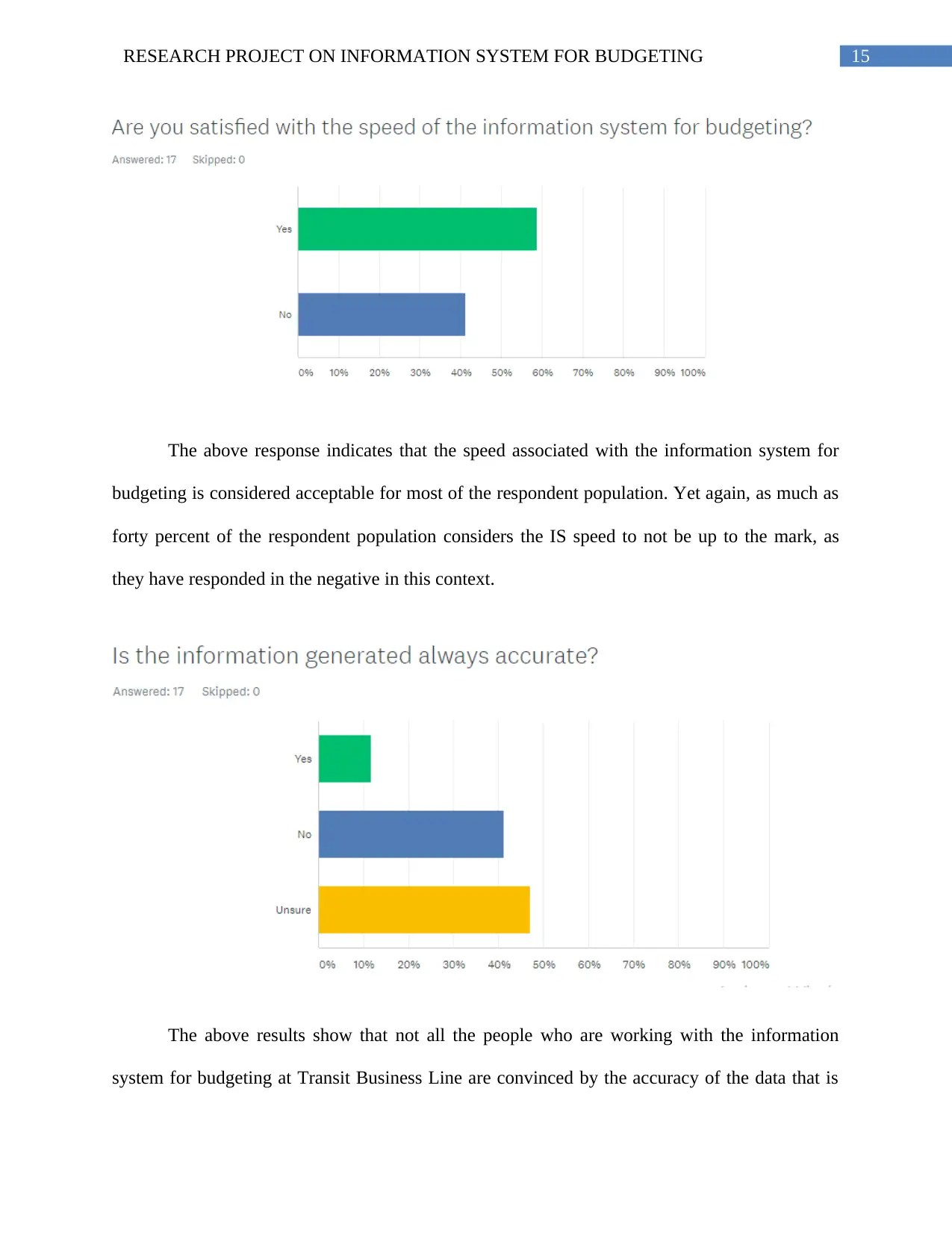
15RESEARCH PROJECT ON INFORMATION SYSTEM FOR BUDGETING
The above response indicates that the speed associated with the information system for
budgeting is considered acceptable for most of the respondent population. Yet again, as much as
forty percent of the respondent population considers the IS speed to not be up to the mark, as
they have responded in the negative in this context.
The above results show that not all the people who are working with the information
system for budgeting at Transit Business Line are convinced by the accuracy of the data that is
The above response indicates that the speed associated with the information system for
budgeting is considered acceptable for most of the respondent population. Yet again, as much as
forty percent of the respondent population considers the IS speed to not be up to the mark, as
they have responded in the negative in this context.
The above results show that not all the people who are working with the information
system for budgeting at Transit Business Line are convinced by the accuracy of the data that is
Paraphrase This Document
Need a fresh take? Get an instant paraphrase of this document with our AI Paraphraser
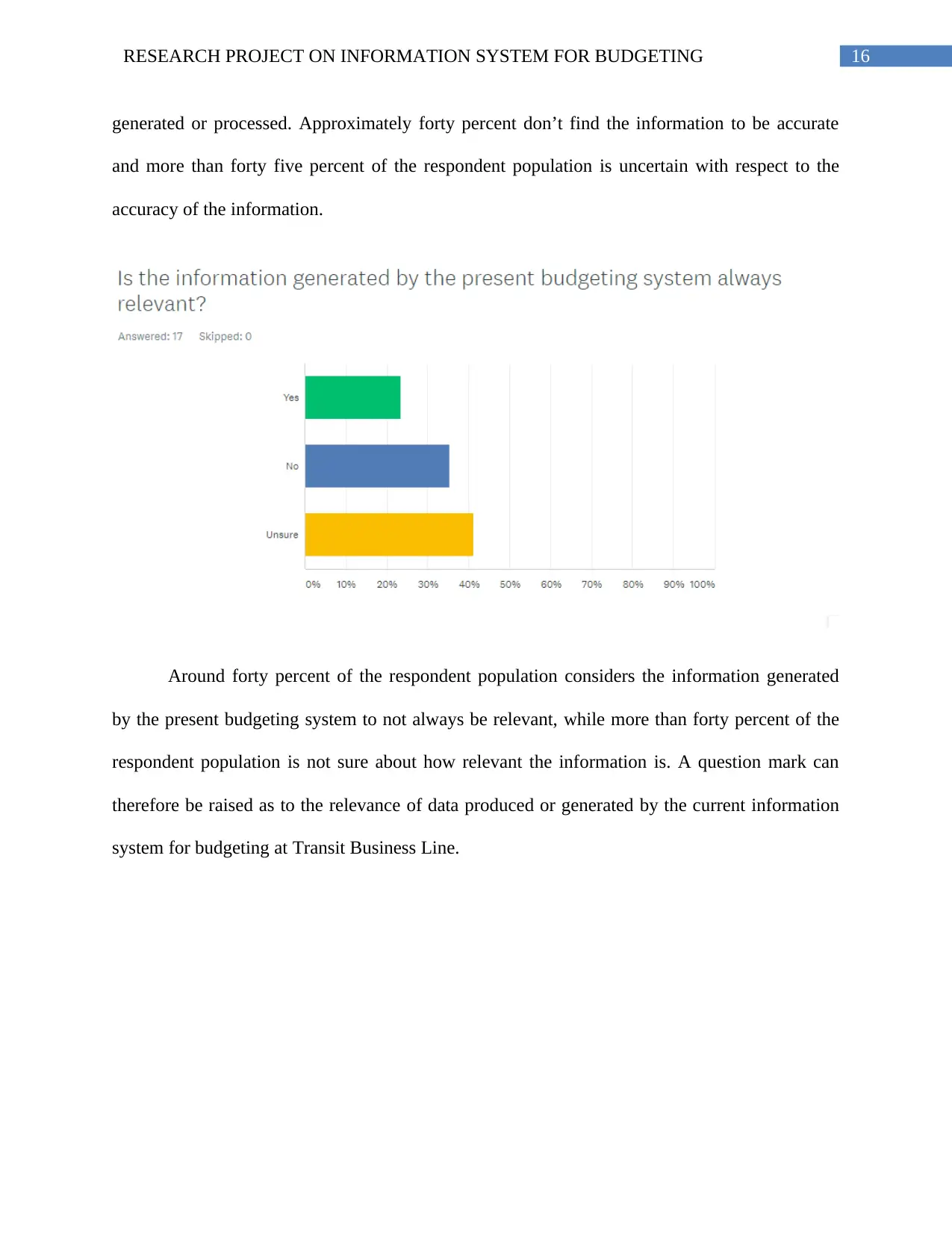
16RESEARCH PROJECT ON INFORMATION SYSTEM FOR BUDGETING
generated or processed. Approximately forty percent don’t find the information to be accurate
and more than forty five percent of the respondent population is uncertain with respect to the
accuracy of the information.
Around forty percent of the respondent population considers the information generated
by the present budgeting system to not always be relevant, while more than forty percent of the
respondent population is not sure about how relevant the information is. A question mark can
therefore be raised as to the relevance of data produced or generated by the current information
system for budgeting at Transit Business Line.
generated or processed. Approximately forty percent don’t find the information to be accurate
and more than forty five percent of the respondent population is uncertain with respect to the
accuracy of the information.
Around forty percent of the respondent population considers the information generated
by the present budgeting system to not always be relevant, while more than forty percent of the
respondent population is not sure about how relevant the information is. A question mark can
therefore be raised as to the relevance of data produced or generated by the current information
system for budgeting at Transit Business Line.
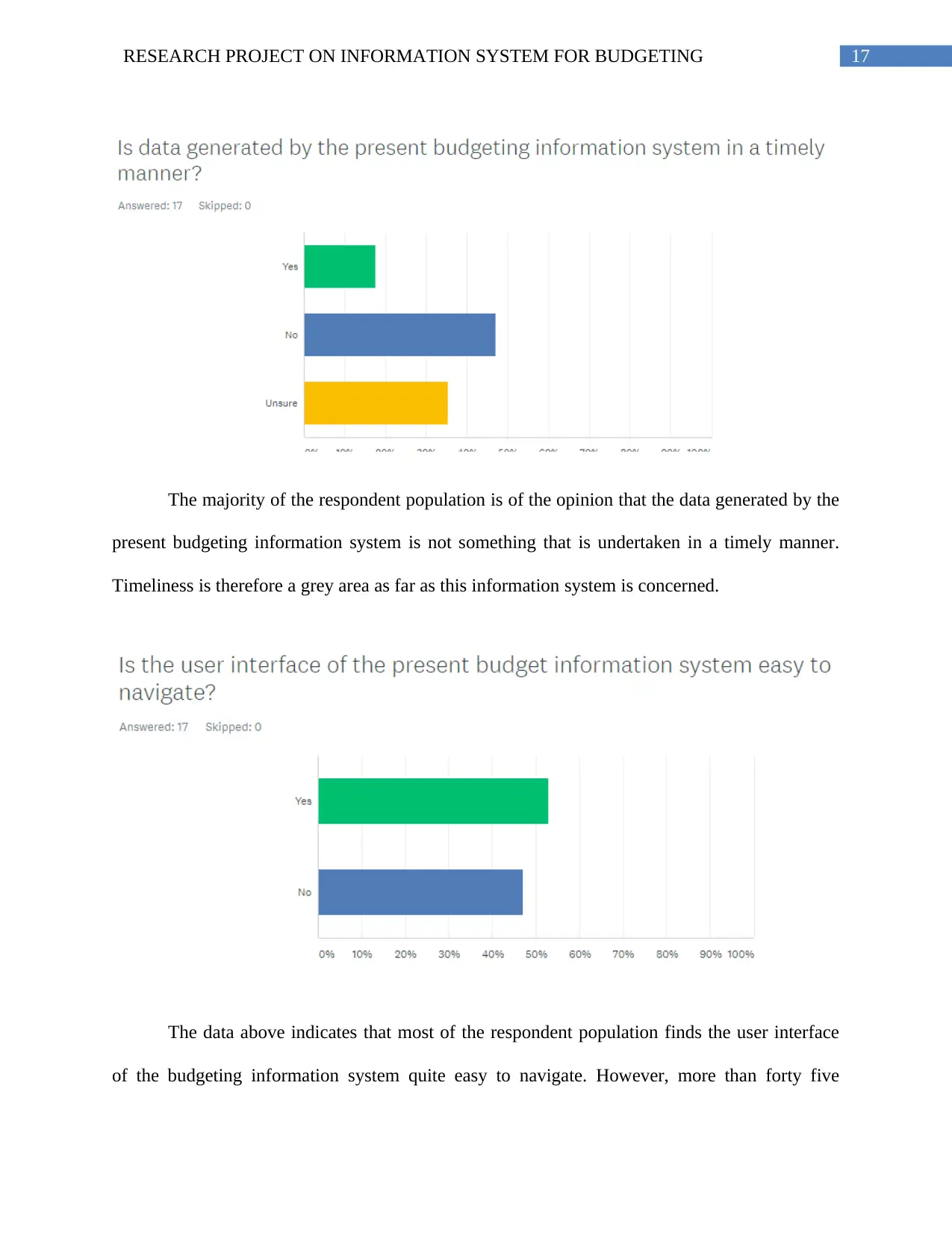
17RESEARCH PROJECT ON INFORMATION SYSTEM FOR BUDGETING
The majority of the respondent population is of the opinion that the data generated by the
present budgeting information system is not something that is undertaken in a timely manner.
Timeliness is therefore a grey area as far as this information system is concerned.
The data above indicates that most of the respondent population finds the user interface
of the budgeting information system quite easy to navigate. However, more than forty five
The majority of the respondent population is of the opinion that the data generated by the
present budgeting information system is not something that is undertaken in a timely manner.
Timeliness is therefore a grey area as far as this information system is concerned.
The data above indicates that most of the respondent population finds the user interface
of the budgeting information system quite easy to navigate. However, more than forty five
You're viewing a preview
Unlock full access by subscribing today!
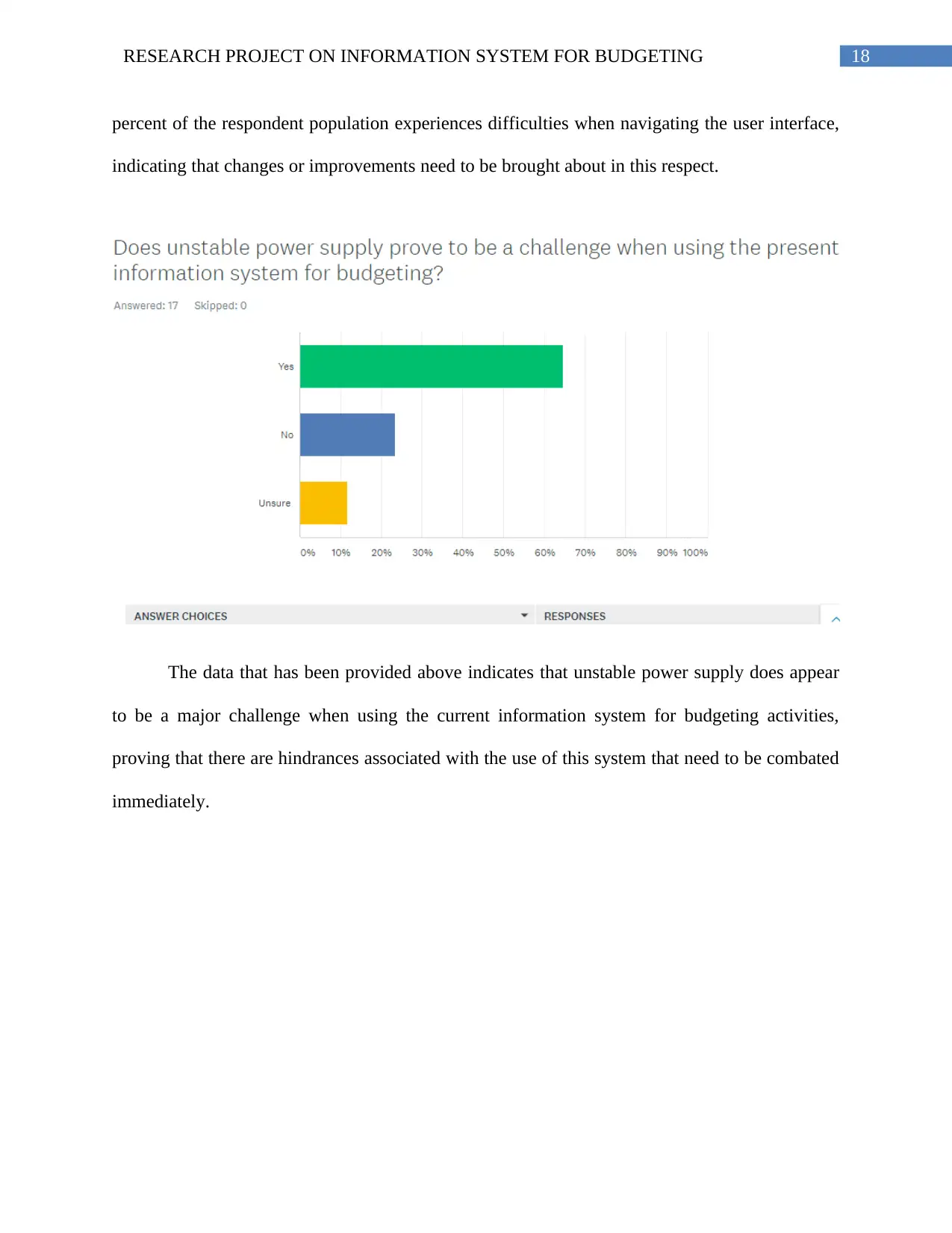
18RESEARCH PROJECT ON INFORMATION SYSTEM FOR BUDGETING
percent of the respondent population experiences difficulties when navigating the user interface,
indicating that changes or improvements need to be brought about in this respect.
The data that has been provided above indicates that unstable power supply does appear
to be a major challenge when using the current information system for budgeting activities,
proving that there are hindrances associated with the use of this system that need to be combated
immediately.
percent of the respondent population experiences difficulties when navigating the user interface,
indicating that changes or improvements need to be brought about in this respect.
The data that has been provided above indicates that unstable power supply does appear
to be a major challenge when using the current information system for budgeting activities,
proving that there are hindrances associated with the use of this system that need to be combated
immediately.
Paraphrase This Document
Need a fresh take? Get an instant paraphrase of this document with our AI Paraphraser
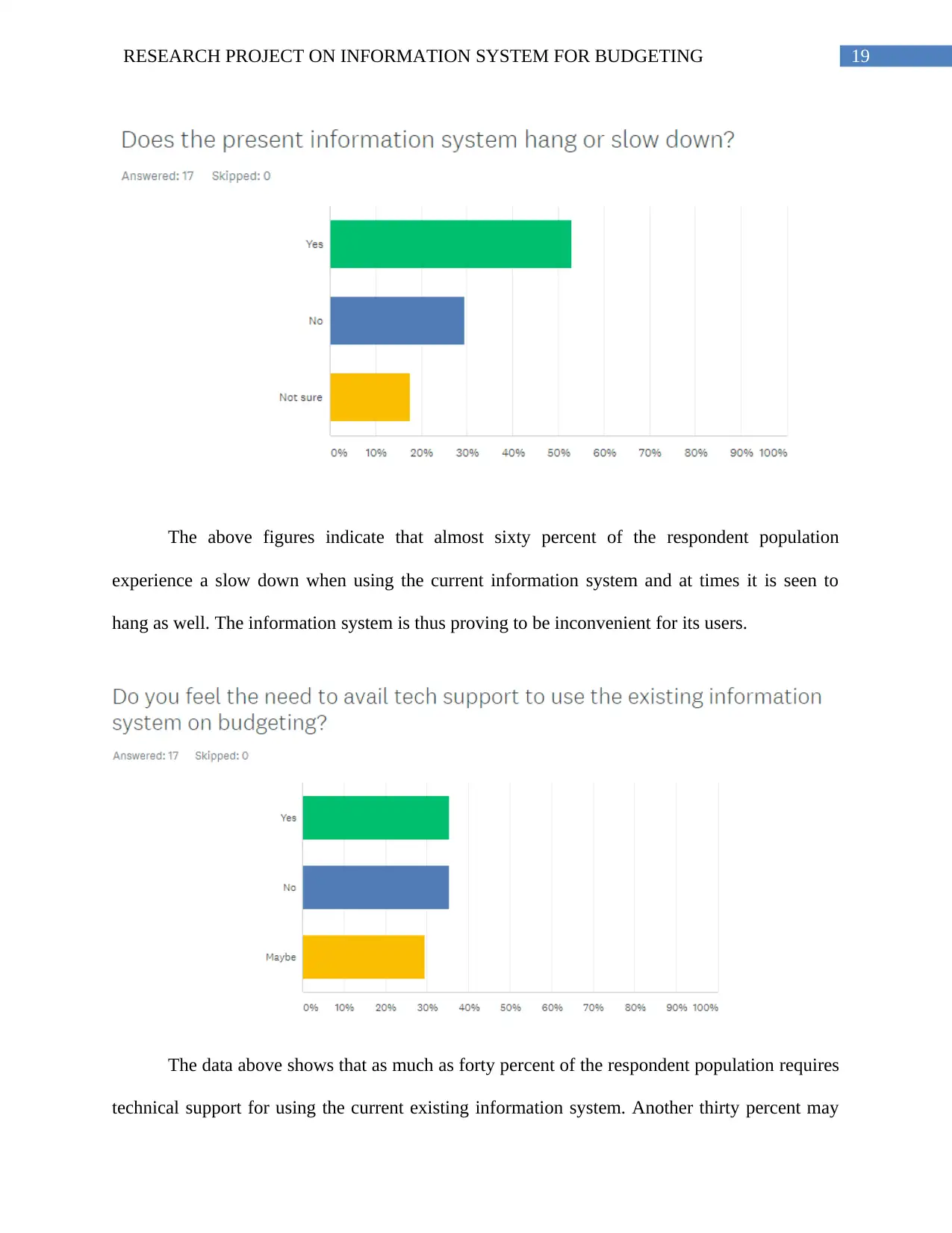
19RESEARCH PROJECT ON INFORMATION SYSTEM FOR BUDGETING
The above figures indicate that almost sixty percent of the respondent population
experience a slow down when using the current information system and at times it is seen to
hang as well. The information system is thus proving to be inconvenient for its users.
The data above shows that as much as forty percent of the respondent population requires
technical support for using the current existing information system. Another thirty percent may
The above figures indicate that almost sixty percent of the respondent population
experience a slow down when using the current information system and at times it is seen to
hang as well. The information system is thus proving to be inconvenient for its users.
The data above shows that as much as forty percent of the respondent population requires
technical support for using the current existing information system. Another thirty percent may
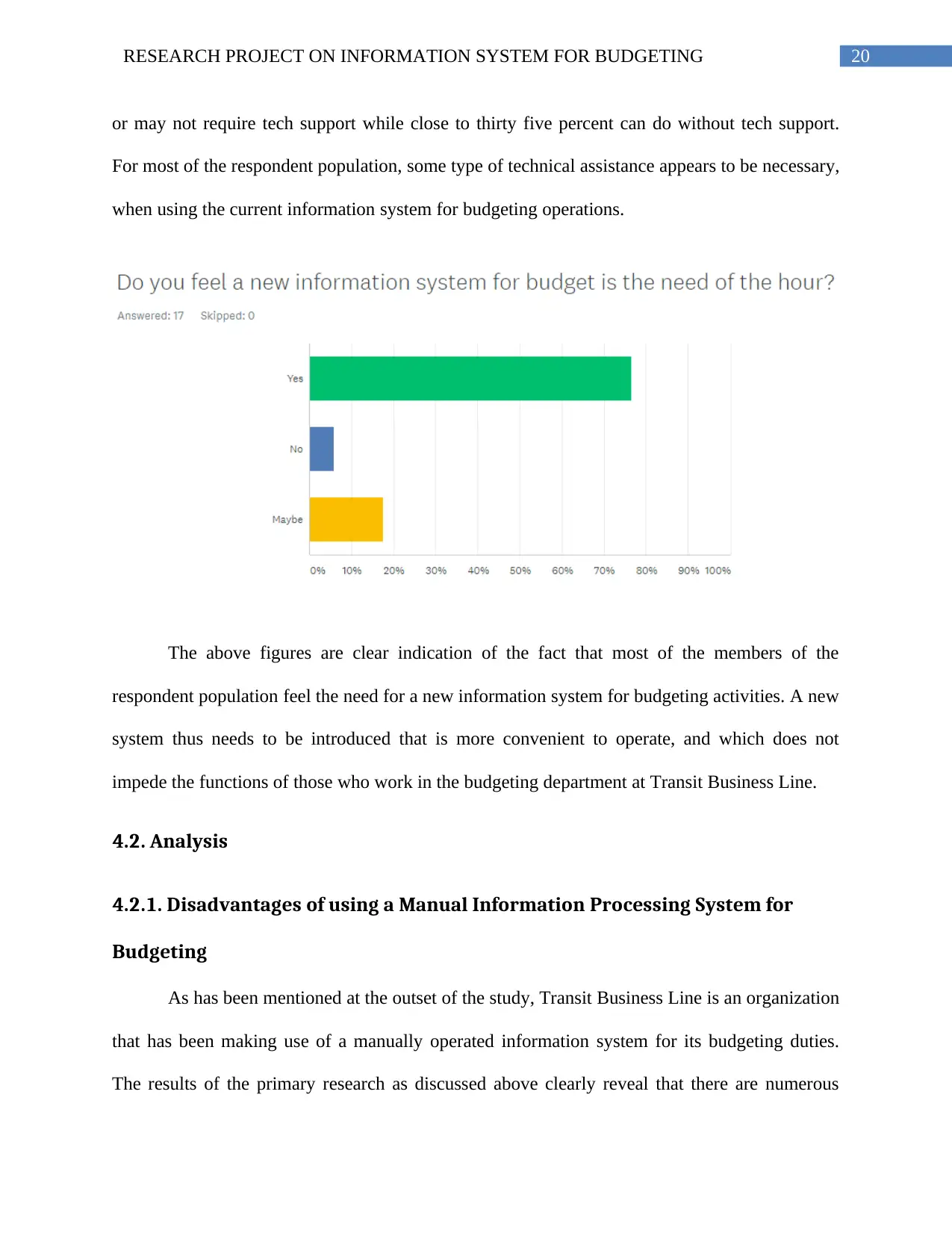
20RESEARCH PROJECT ON INFORMATION SYSTEM FOR BUDGETING
or may not require tech support while close to thirty five percent can do without tech support.
For most of the respondent population, some type of technical assistance appears to be necessary,
when using the current information system for budgeting operations.
The above figures are clear indication of the fact that most of the members of the
respondent population feel the need for a new information system for budgeting activities. A new
system thus needs to be introduced that is more convenient to operate, and which does not
impede the functions of those who work in the budgeting department at Transit Business Line.
4.2. Analysis
4.2.1. Disadvantages of using a Manual Information Processing System for
Budgeting
As has been mentioned at the outset of the study, Transit Business Line is an organization
that has been making use of a manually operated information system for its budgeting duties.
The results of the primary research as discussed above clearly reveal that there are numerous
or may not require tech support while close to thirty five percent can do without tech support.
For most of the respondent population, some type of technical assistance appears to be necessary,
when using the current information system for budgeting operations.
The above figures are clear indication of the fact that most of the members of the
respondent population feel the need for a new information system for budgeting activities. A new
system thus needs to be introduced that is more convenient to operate, and which does not
impede the functions of those who work in the budgeting department at Transit Business Line.
4.2. Analysis
4.2.1. Disadvantages of using a Manual Information Processing System for
Budgeting
As has been mentioned at the outset of the study, Transit Business Line is an organization
that has been making use of a manually operated information system for its budgeting duties.
The results of the primary research as discussed above clearly reveal that there are numerous
You're viewing a preview
Unlock full access by subscribing today!
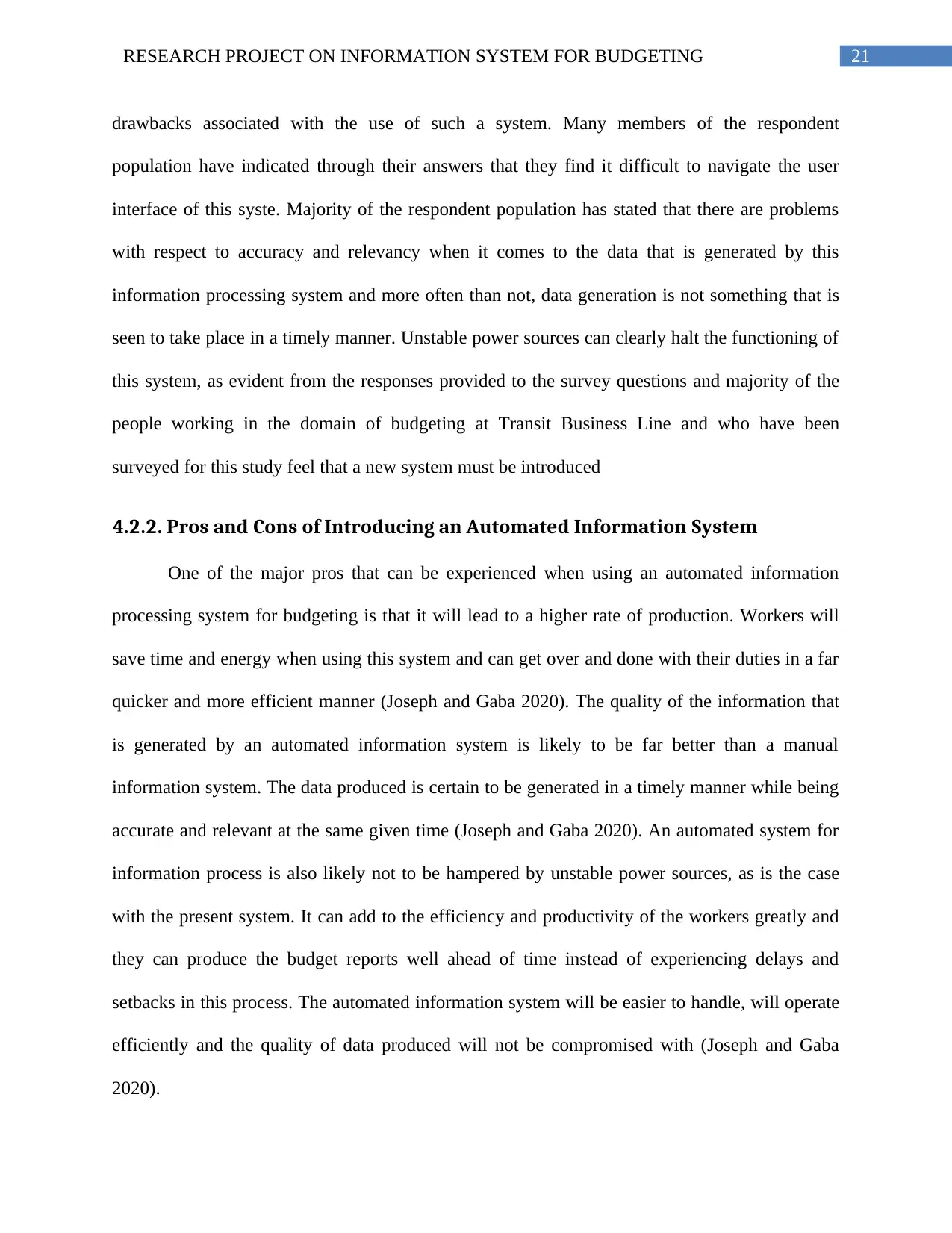
21RESEARCH PROJECT ON INFORMATION SYSTEM FOR BUDGETING
drawbacks associated with the use of such a system. Many members of the respondent
population have indicated through their answers that they find it difficult to navigate the user
interface of this syste. Majority of the respondent population has stated that there are problems
with respect to accuracy and relevancy when it comes to the data that is generated by this
information processing system and more often than not, data generation is not something that is
seen to take place in a timely manner. Unstable power sources can clearly halt the functioning of
this system, as evident from the responses provided to the survey questions and majority of the
people working in the domain of budgeting at Transit Business Line and who have been
surveyed for this study feel that a new system must be introduced
4.2.2. Pros and Cons of Introducing an Automated Information System
One of the major pros that can be experienced when using an automated information
processing system for budgeting is that it will lead to a higher rate of production. Workers will
save time and energy when using this system and can get over and done with their duties in a far
quicker and more efficient manner (Joseph and Gaba 2020). The quality of the information that
is generated by an automated information system is likely to be far better than a manual
information system. The data produced is certain to be generated in a timely manner while being
accurate and relevant at the same given time (Joseph and Gaba 2020). An automated system for
information process is also likely not to be hampered by unstable power sources, as is the case
with the present system. It can add to the efficiency and productivity of the workers greatly and
they can produce the budget reports well ahead of time instead of experiencing delays and
setbacks in this process. The automated information system will be easier to handle, will operate
efficiently and the quality of data produced will not be compromised with (Joseph and Gaba
2020).
drawbacks associated with the use of such a system. Many members of the respondent
population have indicated through their answers that they find it difficult to navigate the user
interface of this syste. Majority of the respondent population has stated that there are problems
with respect to accuracy and relevancy when it comes to the data that is generated by this
information processing system and more often than not, data generation is not something that is
seen to take place in a timely manner. Unstable power sources can clearly halt the functioning of
this system, as evident from the responses provided to the survey questions and majority of the
people working in the domain of budgeting at Transit Business Line and who have been
surveyed for this study feel that a new system must be introduced
4.2.2. Pros and Cons of Introducing an Automated Information System
One of the major pros that can be experienced when using an automated information
processing system for budgeting is that it will lead to a higher rate of production. Workers will
save time and energy when using this system and can get over and done with their duties in a far
quicker and more efficient manner (Joseph and Gaba 2020). The quality of the information that
is generated by an automated information system is likely to be far better than a manual
information system. The data produced is certain to be generated in a timely manner while being
accurate and relevant at the same given time (Joseph and Gaba 2020). An automated system for
information process is also likely not to be hampered by unstable power sources, as is the case
with the present system. It can add to the efficiency and productivity of the workers greatly and
they can produce the budget reports well ahead of time instead of experiencing delays and
setbacks in this process. The automated information system will be easier to handle, will operate
efficiently and the quality of data produced will not be compromised with (Joseph and Gaba
2020).
Paraphrase This Document
Need a fresh take? Get an instant paraphrase of this document with our AI Paraphraser
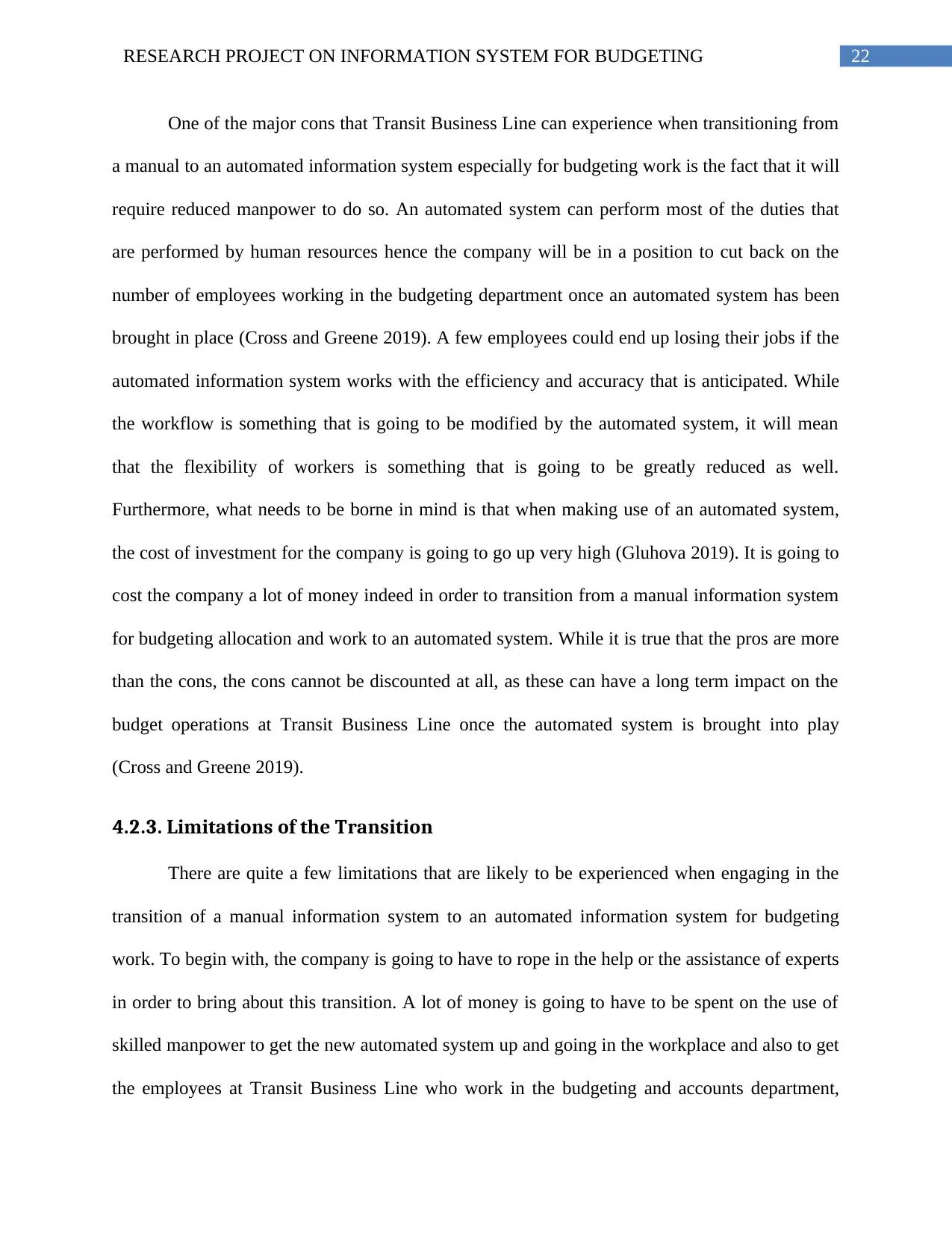
22RESEARCH PROJECT ON INFORMATION SYSTEM FOR BUDGETING
One of the major cons that Transit Business Line can experience when transitioning from
a manual to an automated information system especially for budgeting work is the fact that it will
require reduced manpower to do so. An automated system can perform most of the duties that
are performed by human resources hence the company will be in a position to cut back on the
number of employees working in the budgeting department once an automated system has been
brought in place (Cross and Greene 2019). A few employees could end up losing their jobs if the
automated information system works with the efficiency and accuracy that is anticipated. While
the workflow is something that is going to be modified by the automated system, it will mean
that the flexibility of workers is something that is going to be greatly reduced as well.
Furthermore, what needs to be borne in mind is that when making use of an automated system,
the cost of investment for the company is going to go up very high (Gluhova 2019). It is going to
cost the company a lot of money indeed in order to transition from a manual information system
for budgeting allocation and work to an automated system. While it is true that the pros are more
than the cons, the cons cannot be discounted at all, as these can have a long term impact on the
budget operations at Transit Business Line once the automated system is brought into play
(Cross and Greene 2019).
4.2.3. Limitations of the Transition
There are quite a few limitations that are likely to be experienced when engaging in the
transition of a manual information system to an automated information system for budgeting
work. To begin with, the company is going to have to rope in the help or the assistance of experts
in order to bring about this transition. A lot of money is going to have to be spent on the use of
skilled manpower to get the new automated system up and going in the workplace and also to get
the employees at Transit Business Line who work in the budgeting and accounts department,
One of the major cons that Transit Business Line can experience when transitioning from
a manual to an automated information system especially for budgeting work is the fact that it will
require reduced manpower to do so. An automated system can perform most of the duties that
are performed by human resources hence the company will be in a position to cut back on the
number of employees working in the budgeting department once an automated system has been
brought in place (Cross and Greene 2019). A few employees could end up losing their jobs if the
automated information system works with the efficiency and accuracy that is anticipated. While
the workflow is something that is going to be modified by the automated system, it will mean
that the flexibility of workers is something that is going to be greatly reduced as well.
Furthermore, what needs to be borne in mind is that when making use of an automated system,
the cost of investment for the company is going to go up very high (Gluhova 2019). It is going to
cost the company a lot of money indeed in order to transition from a manual information system
for budgeting allocation and work to an automated system. While it is true that the pros are more
than the cons, the cons cannot be discounted at all, as these can have a long term impact on the
budget operations at Transit Business Line once the automated system is brought into play
(Cross and Greene 2019).
4.2.3. Limitations of the Transition
There are quite a few limitations that are likely to be experienced when engaging in the
transition of a manual information system to an automated information system for budgeting
work. To begin with, the company is going to have to rope in the help or the assistance of experts
in order to bring about this transition. A lot of money is going to have to be spent on the use of
skilled manpower to get the new automated system up and going in the workplace and also to get
the employees at Transit Business Line who work in the budgeting and accounts department,
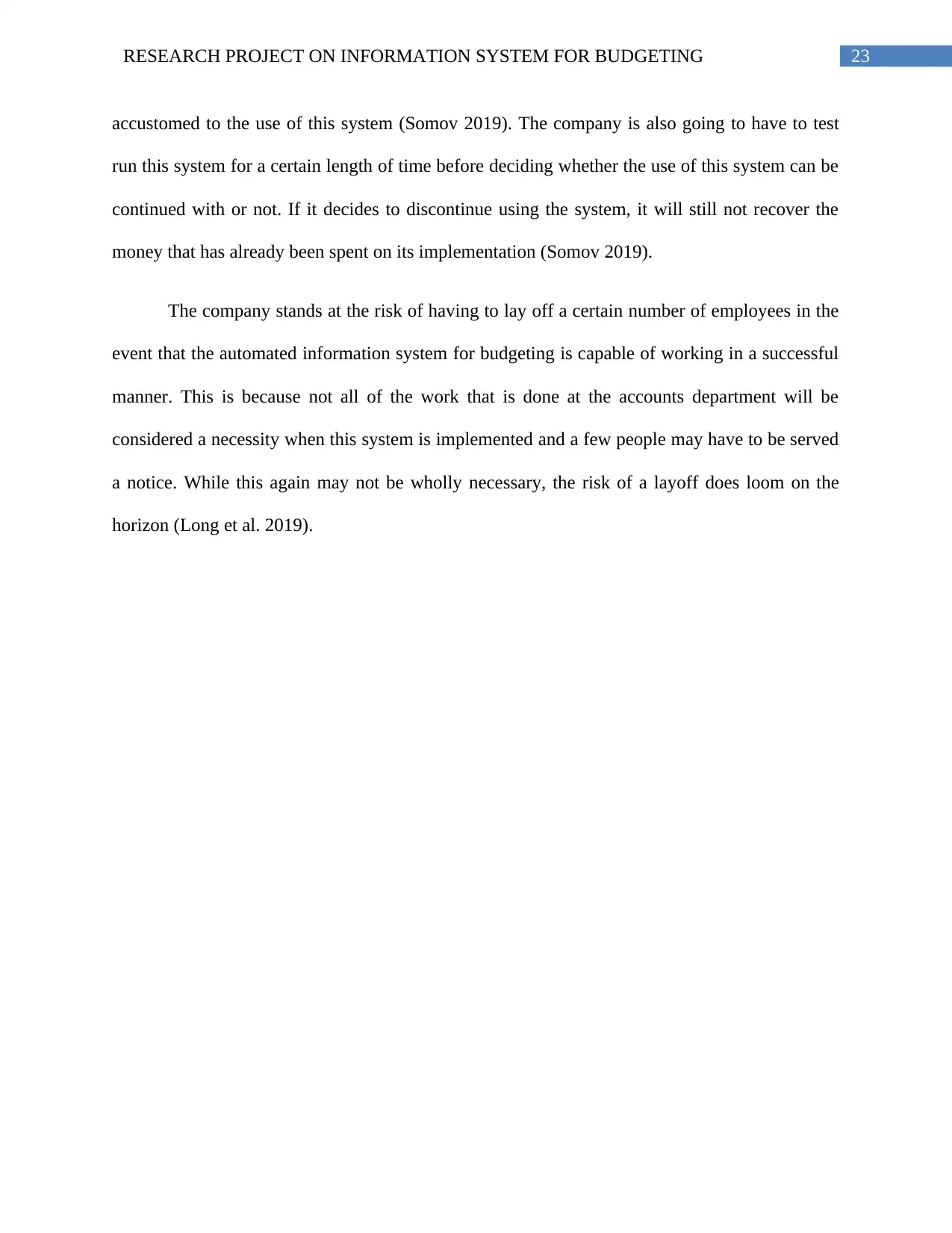
23RESEARCH PROJECT ON INFORMATION SYSTEM FOR BUDGETING
accustomed to the use of this system (Somov 2019). The company is also going to have to test
run this system for a certain length of time before deciding whether the use of this system can be
continued with or not. If it decides to discontinue using the system, it will still not recover the
money that has already been spent on its implementation (Somov 2019).
The company stands at the risk of having to lay off a certain number of employees in the
event that the automated information system for budgeting is capable of working in a successful
manner. This is because not all of the work that is done at the accounts department will be
considered a necessity when this system is implemented and a few people may have to be served
a notice. While this again may not be wholly necessary, the risk of a layoff does loom on the
horizon (Long et al. 2019).
accustomed to the use of this system (Somov 2019). The company is also going to have to test
run this system for a certain length of time before deciding whether the use of this system can be
continued with or not. If it decides to discontinue using the system, it will still not recover the
money that has already been spent on its implementation (Somov 2019).
The company stands at the risk of having to lay off a certain number of employees in the
event that the automated information system for budgeting is capable of working in a successful
manner. This is because not all of the work that is done at the accounts department will be
considered a necessity when this system is implemented and a few people may have to be served
a notice. While this again may not be wholly necessary, the risk of a layoff does loom on the
horizon (Long et al. 2019).
You're viewing a preview
Unlock full access by subscribing today!
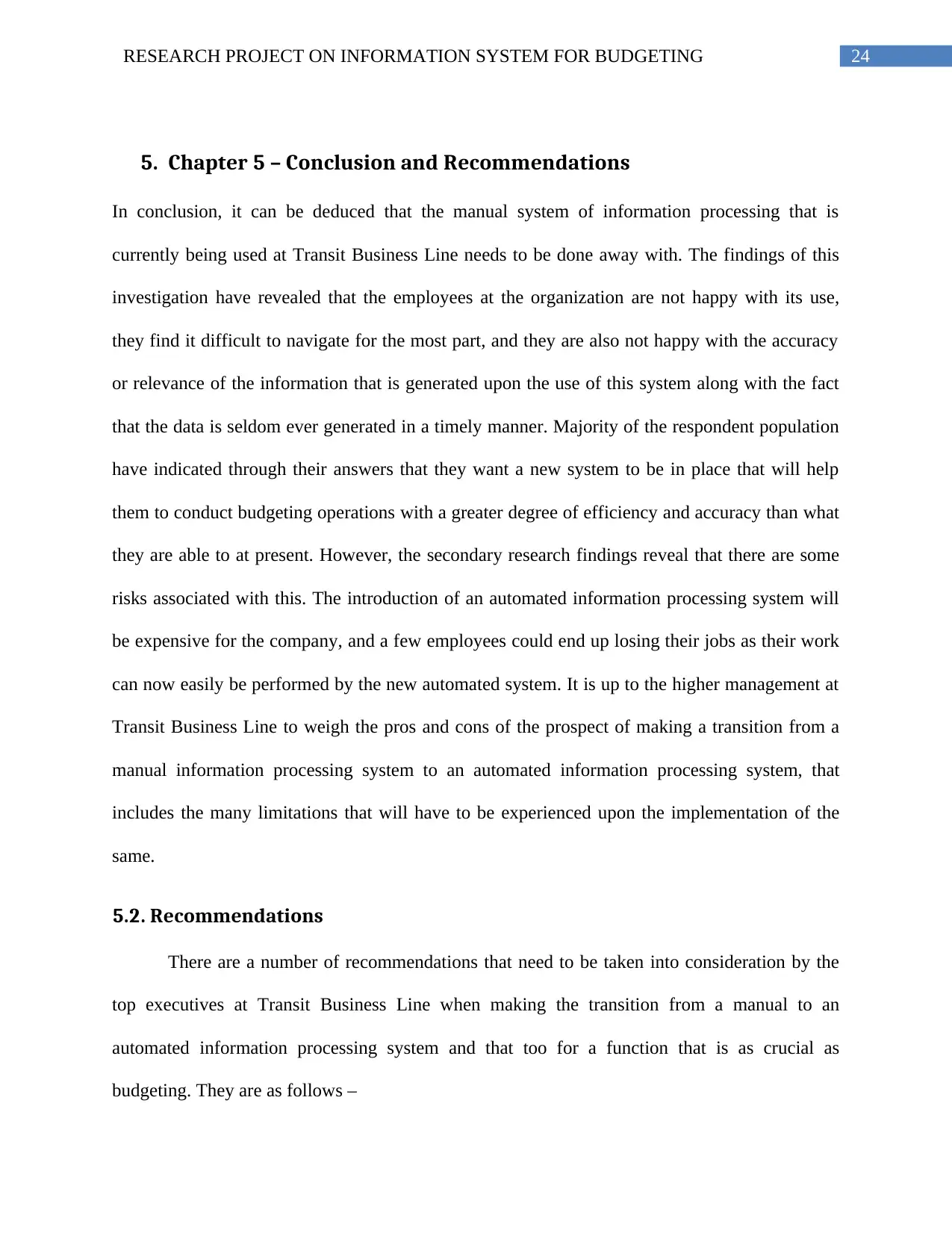
24RESEARCH PROJECT ON INFORMATION SYSTEM FOR BUDGETING
5. Chapter 5 – Conclusion and Recommendations
In conclusion, it can be deduced that the manual system of information processing that is
currently being used at Transit Business Line needs to be done away with. The findings of this
investigation have revealed that the employees at the organization are not happy with its use,
they find it difficult to navigate for the most part, and they are also not happy with the accuracy
or relevance of the information that is generated upon the use of this system along with the fact
that the data is seldom ever generated in a timely manner. Majority of the respondent population
have indicated through their answers that they want a new system to be in place that will help
them to conduct budgeting operations with a greater degree of efficiency and accuracy than what
they are able to at present. However, the secondary research findings reveal that there are some
risks associated with this. The introduction of an automated information processing system will
be expensive for the company, and a few employees could end up losing their jobs as their work
can now easily be performed by the new automated system. It is up to the higher management at
Transit Business Line to weigh the pros and cons of the prospect of making a transition from a
manual information processing system to an automated information processing system, that
includes the many limitations that will have to be experienced upon the implementation of the
same.
5.2. Recommendations
There are a number of recommendations that need to be taken into consideration by the
top executives at Transit Business Line when making the transition from a manual to an
automated information processing system and that too for a function that is as crucial as
budgeting. They are as follows –
5. Chapter 5 – Conclusion and Recommendations
In conclusion, it can be deduced that the manual system of information processing that is
currently being used at Transit Business Line needs to be done away with. The findings of this
investigation have revealed that the employees at the organization are not happy with its use,
they find it difficult to navigate for the most part, and they are also not happy with the accuracy
or relevance of the information that is generated upon the use of this system along with the fact
that the data is seldom ever generated in a timely manner. Majority of the respondent population
have indicated through their answers that they want a new system to be in place that will help
them to conduct budgeting operations with a greater degree of efficiency and accuracy than what
they are able to at present. However, the secondary research findings reveal that there are some
risks associated with this. The introduction of an automated information processing system will
be expensive for the company, and a few employees could end up losing their jobs as their work
can now easily be performed by the new automated system. It is up to the higher management at
Transit Business Line to weigh the pros and cons of the prospect of making a transition from a
manual information processing system to an automated information processing system, that
includes the many limitations that will have to be experienced upon the implementation of the
same.
5.2. Recommendations
There are a number of recommendations that need to be taken into consideration by the
top executives at Transit Business Line when making the transition from a manual to an
automated information processing system and that too for a function that is as crucial as
budgeting. They are as follows –
Paraphrase This Document
Need a fresh take? Get an instant paraphrase of this document with our AI Paraphraser
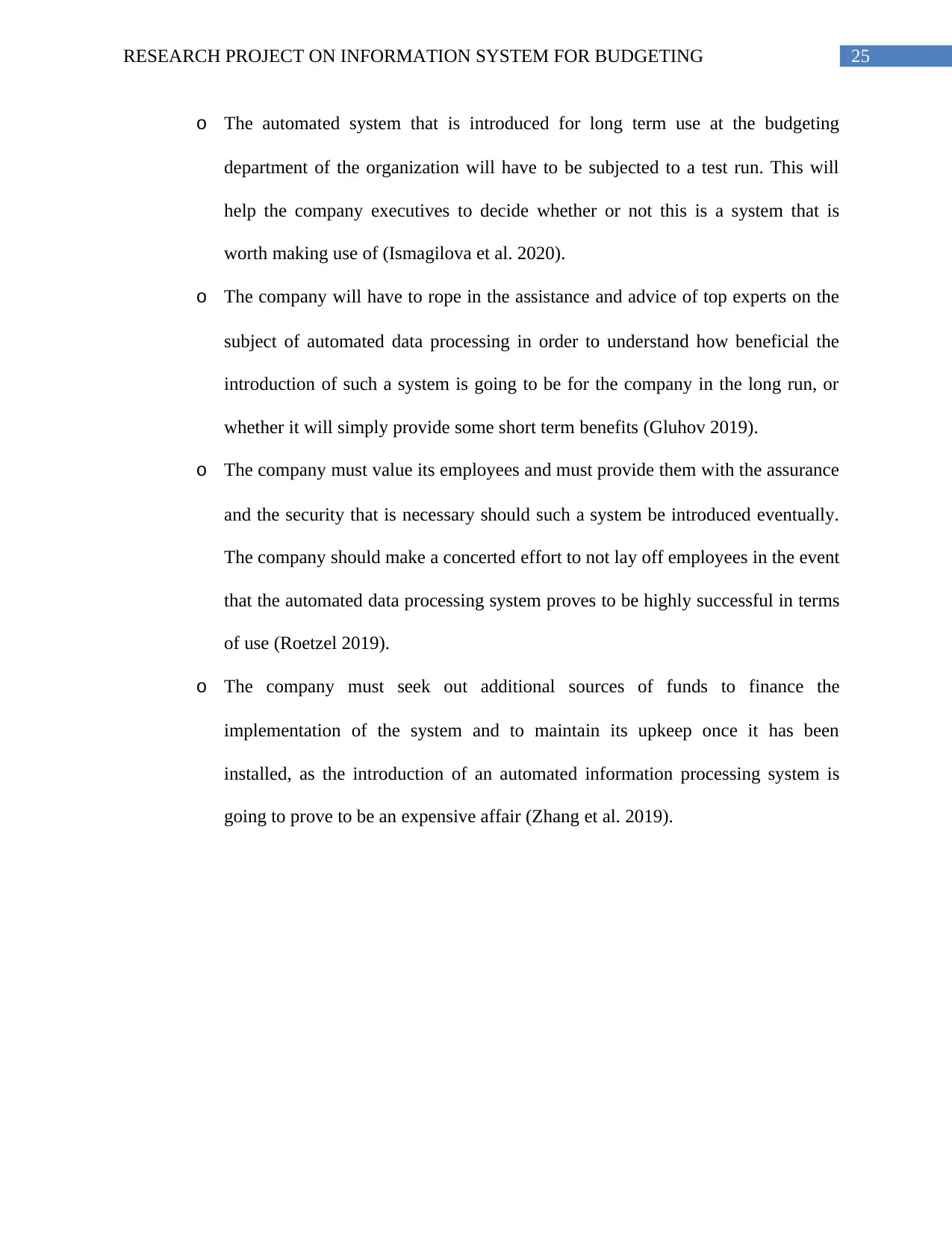
25RESEARCH PROJECT ON INFORMATION SYSTEM FOR BUDGETING
o The automated system that is introduced for long term use at the budgeting
department of the organization will have to be subjected to a test run. This will
help the company executives to decide whether or not this is a system that is
worth making use of (Ismagilova et al. 2020).
o The company will have to rope in the assistance and advice of top experts on the
subject of automated data processing in order to understand how beneficial the
introduction of such a system is going to be for the company in the long run, or
whether it will simply provide some short term benefits (Gluhov 2019).
o The company must value its employees and must provide them with the assurance
and the security that is necessary should such a system be introduced eventually.
The company should make a concerted effort to not lay off employees in the event
that the automated data processing system proves to be highly successful in terms
of use (Roetzel 2019).
o The company must seek out additional sources of funds to finance the
implementation of the system and to maintain its upkeep once it has been
installed, as the introduction of an automated information processing system is
going to prove to be an expensive affair (Zhang et al. 2019).
o The automated system that is introduced for long term use at the budgeting
department of the organization will have to be subjected to a test run. This will
help the company executives to decide whether or not this is a system that is
worth making use of (Ismagilova et al. 2020).
o The company will have to rope in the assistance and advice of top experts on the
subject of automated data processing in order to understand how beneficial the
introduction of such a system is going to be for the company in the long run, or
whether it will simply provide some short term benefits (Gluhov 2019).
o The company must value its employees and must provide them with the assurance
and the security that is necessary should such a system be introduced eventually.
The company should make a concerted effort to not lay off employees in the event
that the automated data processing system proves to be highly successful in terms
of use (Roetzel 2019).
o The company must seek out additional sources of funds to finance the
implementation of the system and to maintain its upkeep once it has been
installed, as the introduction of an automated information processing system is
going to prove to be an expensive affair (Zhang et al. 2019).
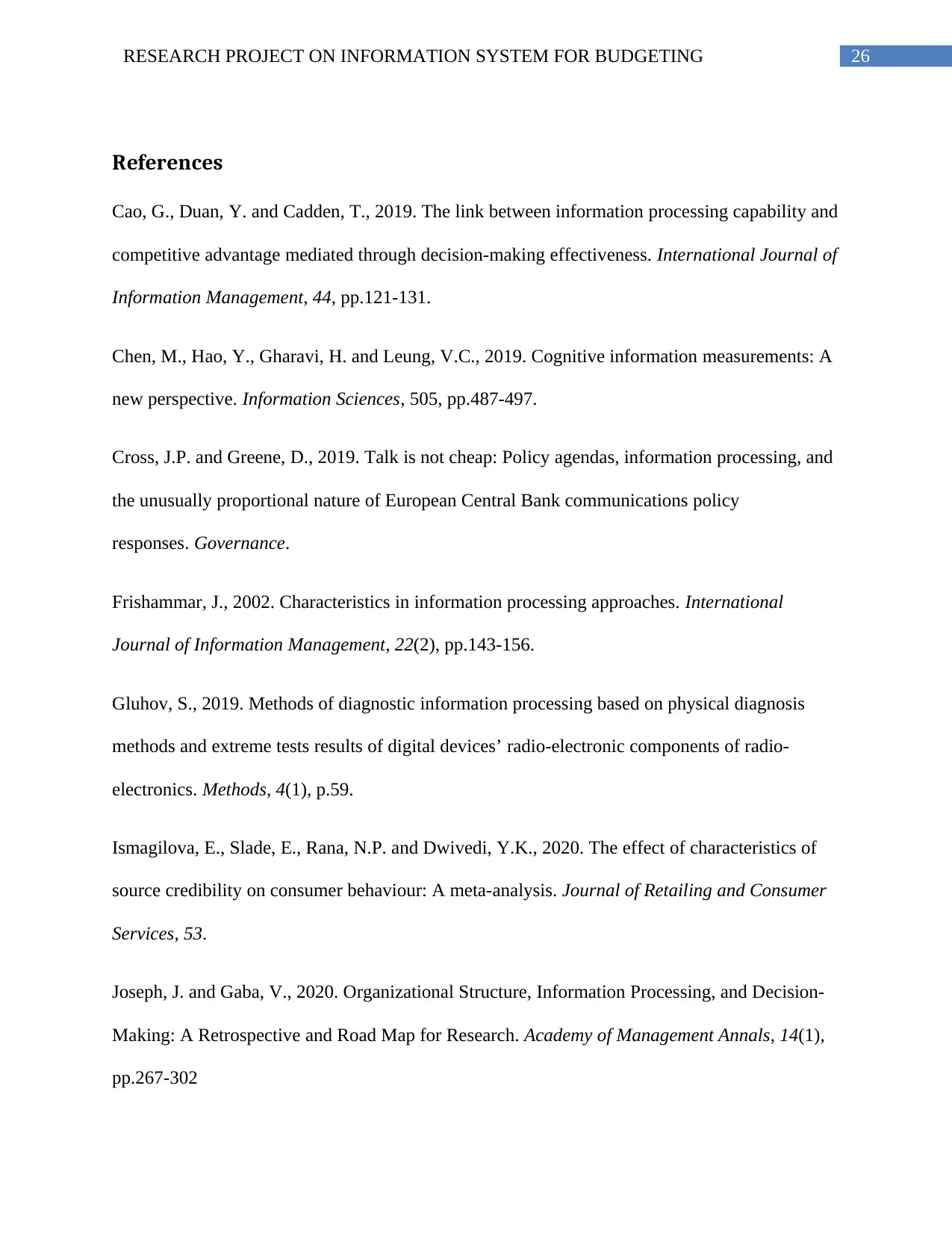
26RESEARCH PROJECT ON INFORMATION SYSTEM FOR BUDGETING
References
Cao, G., Duan, Y. and Cadden, T., 2019. The link between information processing capability and
competitive advantage mediated through decision-making effectiveness. International Journal of
Information Management, 44, pp.121-131.
Chen, M., Hao, Y., Gharavi, H. and Leung, V.C., 2019. Cognitive information measurements: A
new perspective. Information Sciences, 505, pp.487-497.
Cross, J.P. and Greene, D., 2019. Talk is not cheap: Policy agendas, information processing, and
the unusually proportional nature of European Central Bank communications policy
responses. Governance.
Frishammar, J., 2002. Characteristics in information processing approaches. International
Journal of Information Management, 22(2), pp.143-156.
Gluhov, S., 2019. Methods of diagnostic information processing based on physical diagnosis
methods and extreme tests results of digital devices’ radio-electronic components of radio-
electronics. Methods, 4(1), p.59.
Ismagilova, E., Slade, E., Rana, N.P. and Dwivedi, Y.K., 2020. The effect of characteristics of
source credibility on consumer behaviour: A meta-analysis. Journal of Retailing and Consumer
Services, 53.
Joseph, J. and Gaba, V., 2020. Organizational Structure, Information Processing, and Decision-
Making: A Retrospective and Road Map for Research. Academy of Management Annals, 14(1),
pp.267-302
References
Cao, G., Duan, Y. and Cadden, T., 2019. The link between information processing capability and
competitive advantage mediated through decision-making effectiveness. International Journal of
Information Management, 44, pp.121-131.
Chen, M., Hao, Y., Gharavi, H. and Leung, V.C., 2019. Cognitive information measurements: A
new perspective. Information Sciences, 505, pp.487-497.
Cross, J.P. and Greene, D., 2019. Talk is not cheap: Policy agendas, information processing, and
the unusually proportional nature of European Central Bank communications policy
responses. Governance.
Frishammar, J., 2002. Characteristics in information processing approaches. International
Journal of Information Management, 22(2), pp.143-156.
Gluhov, S., 2019. Methods of diagnostic information processing based on physical diagnosis
methods and extreme tests results of digital devices’ radio-electronic components of radio-
electronics. Methods, 4(1), p.59.
Ismagilova, E., Slade, E., Rana, N.P. and Dwivedi, Y.K., 2020. The effect of characteristics of
source credibility on consumer behaviour: A meta-analysis. Journal of Retailing and Consumer
Services, 53.
Joseph, J. and Gaba, V., 2020. Organizational Structure, Information Processing, and Decision-
Making: A Retrospective and Road Map for Research. Academy of Management Annals, 14(1),
pp.267-302
You're viewing a preview
Unlock full access by subscribing today!
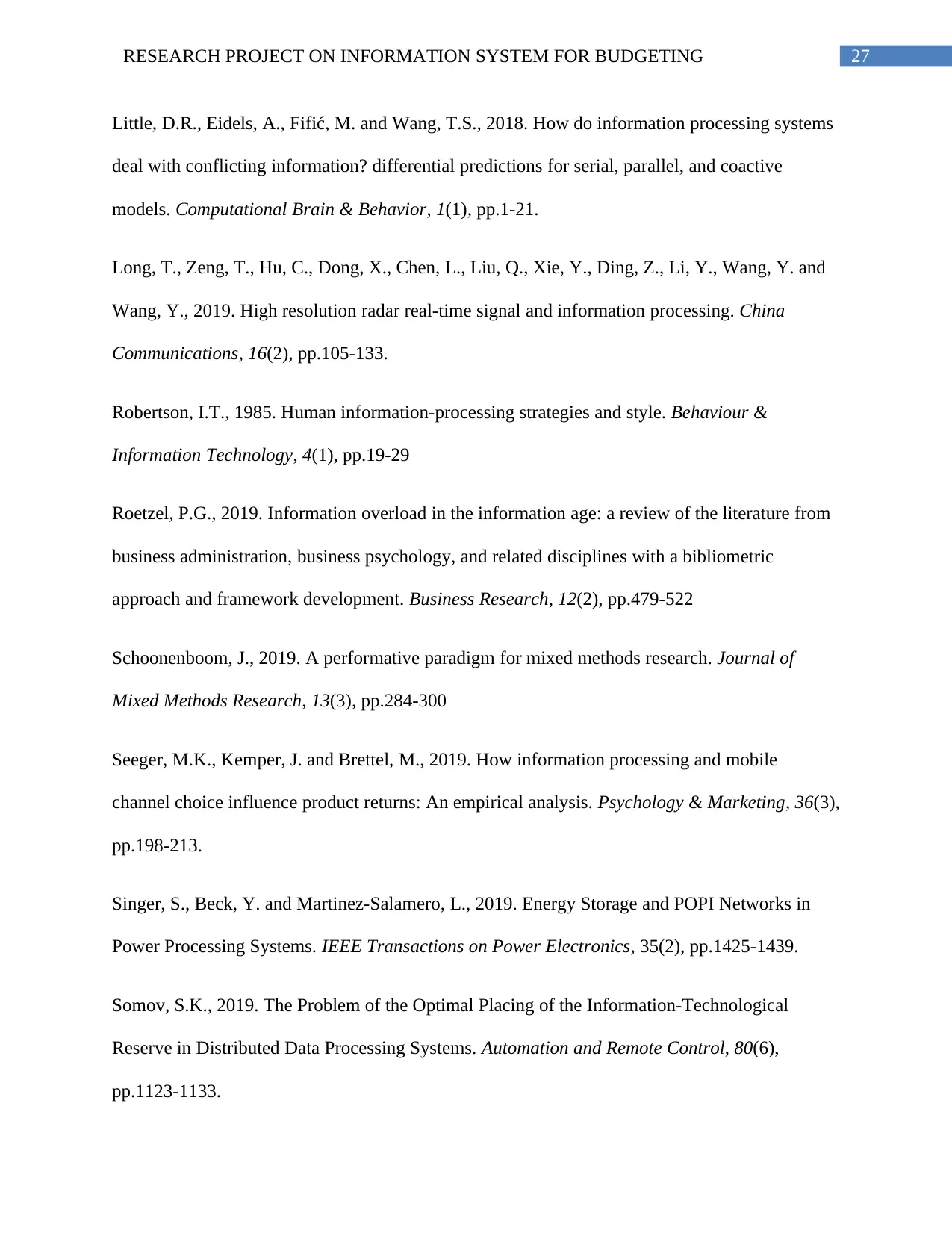
27RESEARCH PROJECT ON INFORMATION SYSTEM FOR BUDGETING
Little, D.R., Eidels, A., Fifić, M. and Wang, T.S., 2018. How do information processing systems
deal with conflicting information? differential predictions for serial, parallel, and coactive
models. Computational Brain & Behavior, 1(1), pp.1-21.
Long, T., Zeng, T., Hu, C., Dong, X., Chen, L., Liu, Q., Xie, Y., Ding, Z., Li, Y., Wang, Y. and
Wang, Y., 2019. High resolution radar real-time signal and information processing. China
Communications, 16(2), pp.105-133.
Robertson, I.T., 1985. Human information-processing strategies and style. Behaviour &
Information Technology, 4(1), pp.19-29
Roetzel, P.G., 2019. Information overload in the information age: a review of the literature from
business administration, business psychology, and related disciplines with a bibliometric
approach and framework development. Business Research, 12(2), pp.479-522
Schoonenboom, J., 2019. A performative paradigm for mixed methods research. Journal of
Mixed Methods Research, 13(3), pp.284-300
Seeger, M.K., Kemper, J. and Brettel, M., 2019. How information processing and mobile
channel choice influence product returns: An empirical analysis. Psychology & Marketing, 36(3),
pp.198-213.
Singer, S., Beck, Y. and Martinez-Salamero, L., 2019. Energy Storage and POPI Networks in
Power Processing Systems. IEEE Transactions on Power Electronics, 35(2), pp.1425-1439.
Somov, S.K., 2019. The Problem of the Optimal Placing of the Information-Technological
Reserve in Distributed Data Processing Systems. Automation and Remote Control, 80(6),
pp.1123-1133.
Little, D.R., Eidels, A., Fifić, M. and Wang, T.S., 2018. How do information processing systems
deal with conflicting information? differential predictions for serial, parallel, and coactive
models. Computational Brain & Behavior, 1(1), pp.1-21.
Long, T., Zeng, T., Hu, C., Dong, X., Chen, L., Liu, Q., Xie, Y., Ding, Z., Li, Y., Wang, Y. and
Wang, Y., 2019. High resolution radar real-time signal and information processing. China
Communications, 16(2), pp.105-133.
Robertson, I.T., 1985. Human information-processing strategies and style. Behaviour &
Information Technology, 4(1), pp.19-29
Roetzel, P.G., 2019. Information overload in the information age: a review of the literature from
business administration, business psychology, and related disciplines with a bibliometric
approach and framework development. Business Research, 12(2), pp.479-522
Schoonenboom, J., 2019. A performative paradigm for mixed methods research. Journal of
Mixed Methods Research, 13(3), pp.284-300
Seeger, M.K., Kemper, J. and Brettel, M., 2019. How information processing and mobile
channel choice influence product returns: An empirical analysis. Psychology & Marketing, 36(3),
pp.198-213.
Singer, S., Beck, Y. and Martinez-Salamero, L., 2019. Energy Storage and POPI Networks in
Power Processing Systems. IEEE Transactions on Power Electronics, 35(2), pp.1425-1439.
Somov, S.K., 2019. The Problem of the Optimal Placing of the Information-Technological
Reserve in Distributed Data Processing Systems. Automation and Remote Control, 80(6),
pp.1123-1133.
Paraphrase This Document
Need a fresh take? Get an instant paraphrase of this document with our AI Paraphraser
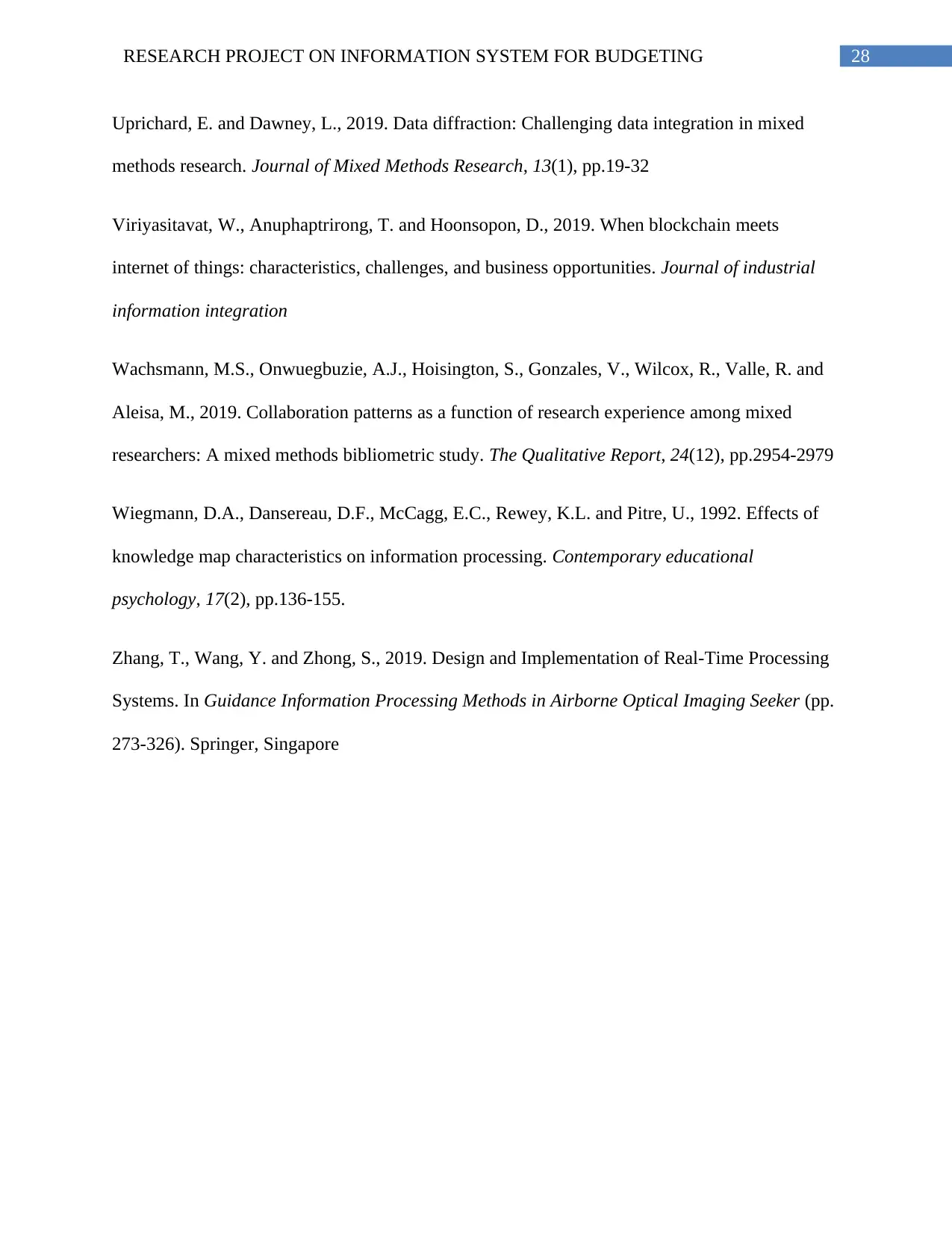
28RESEARCH PROJECT ON INFORMATION SYSTEM FOR BUDGETING
Uprichard, E. and Dawney, L., 2019. Data diffraction: Challenging data integration in mixed
methods research. Journal of Mixed Methods Research, 13(1), pp.19-32
Viriyasitavat, W., Anuphaptrirong, T. and Hoonsopon, D., 2019. When blockchain meets
internet of things: characteristics, challenges, and business opportunities. Journal of industrial
information integration
Wachsmann, M.S., Onwuegbuzie, A.J., Hoisington, S., Gonzales, V., Wilcox, R., Valle, R. and
Aleisa, M., 2019. Collaboration patterns as a function of research experience among mixed
researchers: A mixed methods bibliometric study. The Qualitative Report, 24(12), pp.2954-2979
Wiegmann, D.A., Dansereau, D.F., McCagg, E.C., Rewey, K.L. and Pitre, U., 1992. Effects of
knowledge map characteristics on information processing. Contemporary educational
psychology, 17(2), pp.136-155.
Zhang, T., Wang, Y. and Zhong, S., 2019. Design and Implementation of Real-Time Processing
Systems. In Guidance Information Processing Methods in Airborne Optical Imaging Seeker (pp.
273-326). Springer, Singapore
Uprichard, E. and Dawney, L., 2019. Data diffraction: Challenging data integration in mixed
methods research. Journal of Mixed Methods Research, 13(1), pp.19-32
Viriyasitavat, W., Anuphaptrirong, T. and Hoonsopon, D., 2019. When blockchain meets
internet of things: characteristics, challenges, and business opportunities. Journal of industrial
information integration
Wachsmann, M.S., Onwuegbuzie, A.J., Hoisington, S., Gonzales, V., Wilcox, R., Valle, R. and
Aleisa, M., 2019. Collaboration patterns as a function of research experience among mixed
researchers: A mixed methods bibliometric study. The Qualitative Report, 24(12), pp.2954-2979
Wiegmann, D.A., Dansereau, D.F., McCagg, E.C., Rewey, K.L. and Pitre, U., 1992. Effects of
knowledge map characteristics on information processing. Contemporary educational
psychology, 17(2), pp.136-155.
Zhang, T., Wang, Y. and Zhong, S., 2019. Design and Implementation of Real-Time Processing
Systems. In Guidance Information Processing Methods in Airborne Optical Imaging Seeker (pp.
273-326). Springer, Singapore
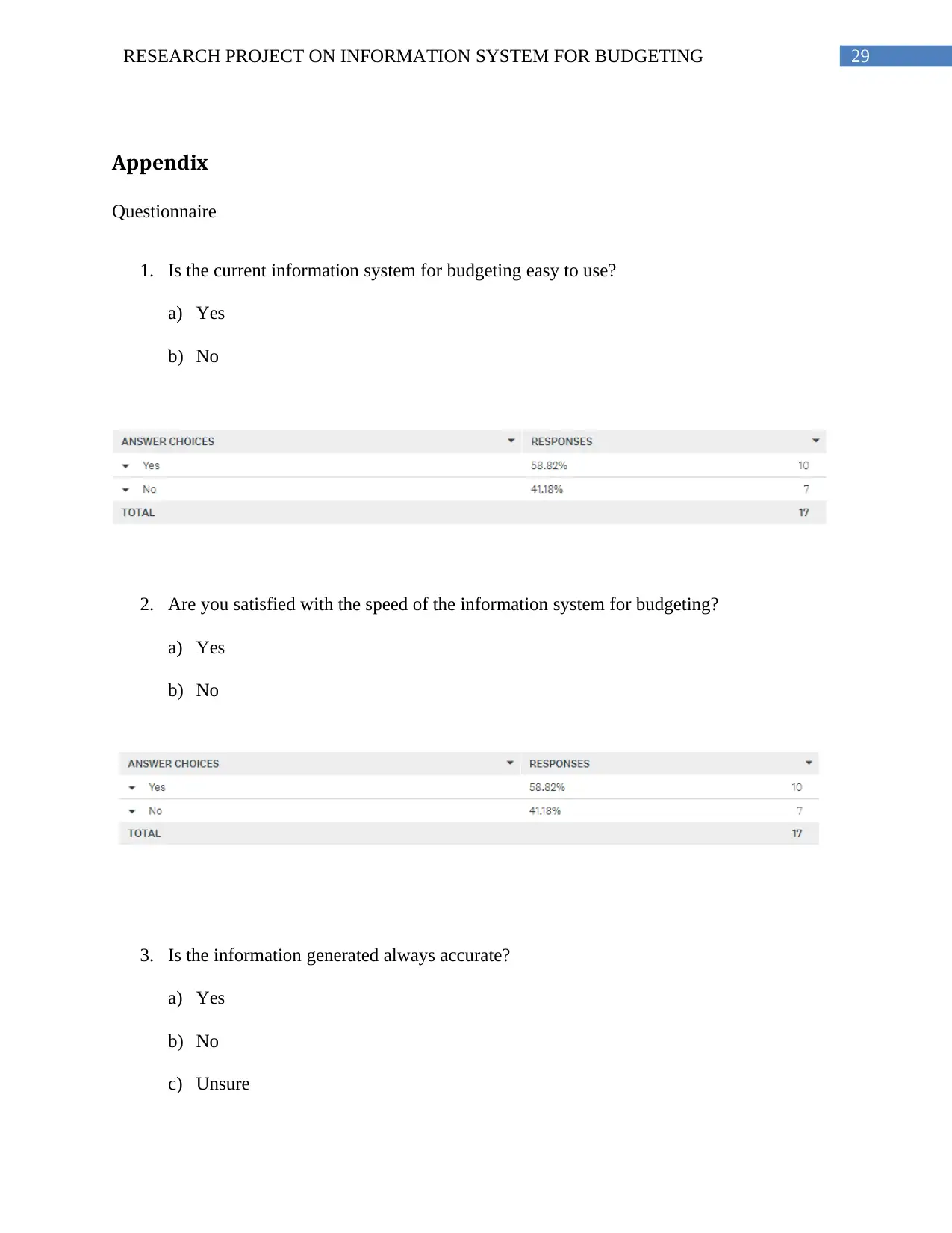
29RESEARCH PROJECT ON INFORMATION SYSTEM FOR BUDGETING
Appendix
Questionnaire
1. Is the current information system for budgeting easy to use?
a) Yes
b) No
2. Are you satisfied with the speed of the information system for budgeting?
a) Yes
b) No
3. Is the information generated always accurate?
a) Yes
b) No
c) Unsure
Appendix
Questionnaire
1. Is the current information system for budgeting easy to use?
a) Yes
b) No
2. Are you satisfied with the speed of the information system for budgeting?
a) Yes
b) No
3. Is the information generated always accurate?
a) Yes
b) No
c) Unsure
You're viewing a preview
Unlock full access by subscribing today!
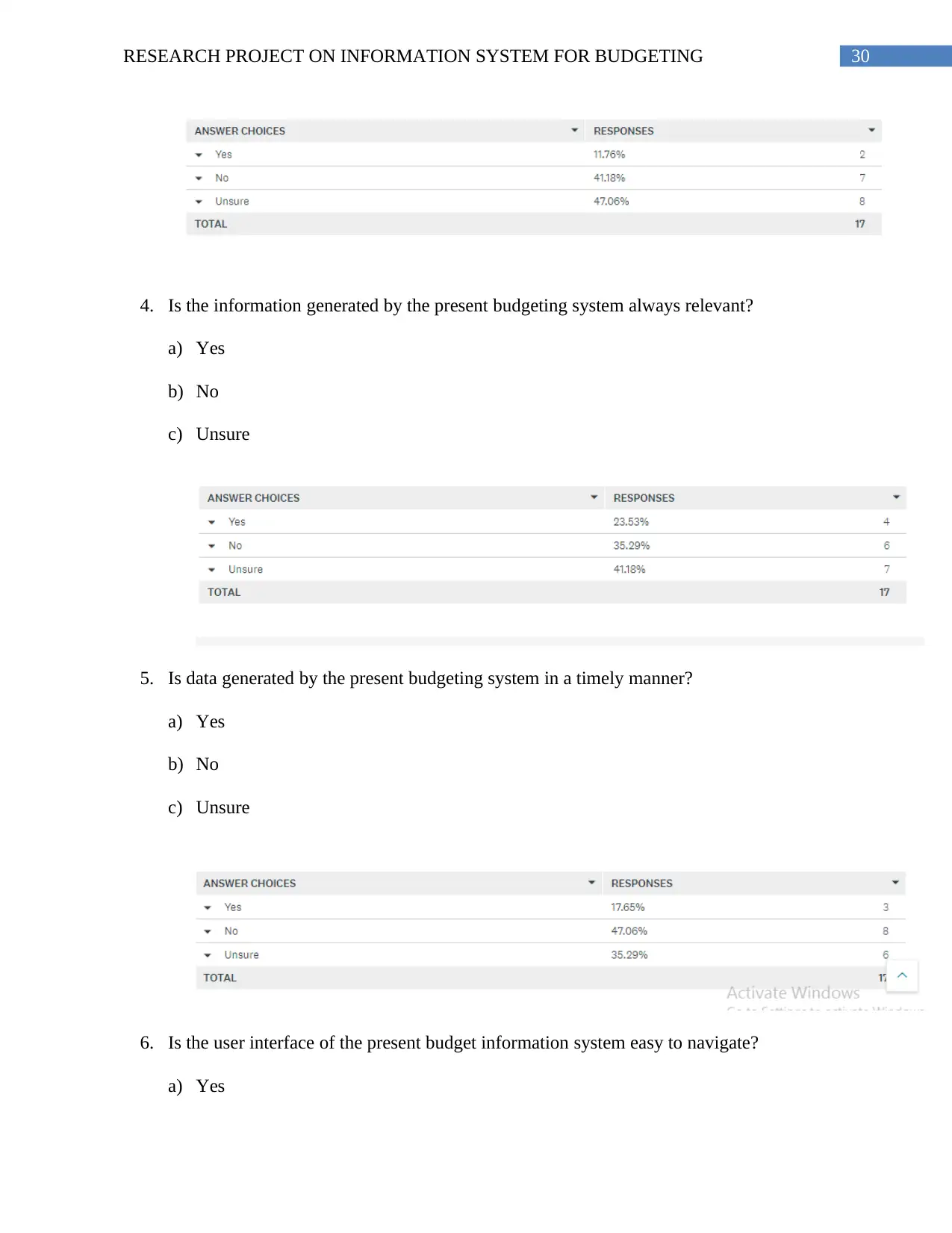
30RESEARCH PROJECT ON INFORMATION SYSTEM FOR BUDGETING
4. Is the information generated by the present budgeting system always relevant?
a) Yes
b) No
c) Unsure
5. Is data generated by the present budgeting system in a timely manner?
a) Yes
b) No
c) Unsure
6. Is the user interface of the present budget information system easy to navigate?
a) Yes
4. Is the information generated by the present budgeting system always relevant?
a) Yes
b) No
c) Unsure
5. Is data generated by the present budgeting system in a timely manner?
a) Yes
b) No
c) Unsure
6. Is the user interface of the present budget information system easy to navigate?
a) Yes
Paraphrase This Document
Need a fresh take? Get an instant paraphrase of this document with our AI Paraphraser
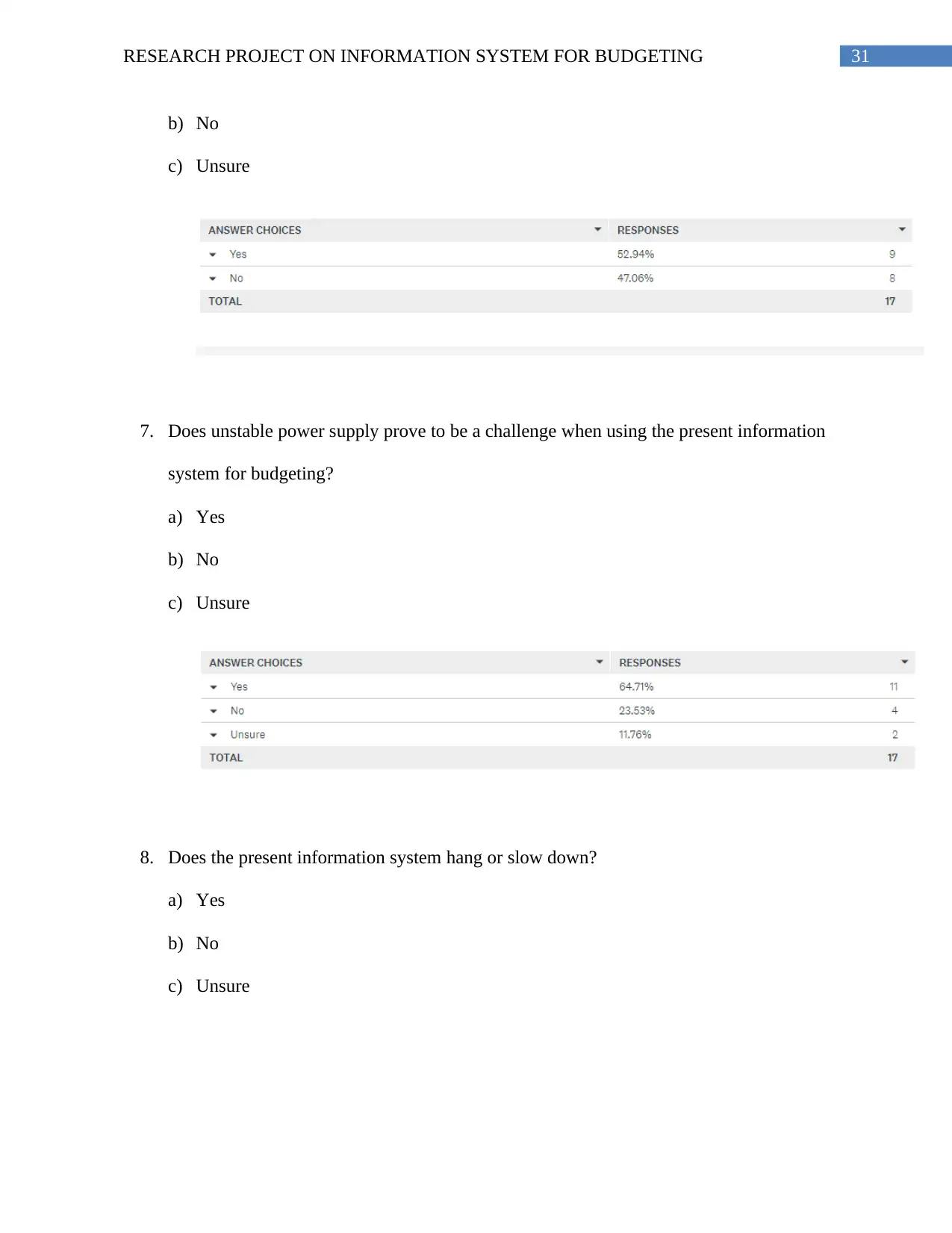
31RESEARCH PROJECT ON INFORMATION SYSTEM FOR BUDGETING
b) No
c) Unsure
7. Does unstable power supply prove to be a challenge when using the present information
system for budgeting?
a) Yes
b) No
c) Unsure
8. Does the present information system hang or slow down?
a) Yes
b) No
c) Unsure
b) No
c) Unsure
7. Does unstable power supply prove to be a challenge when using the present information
system for budgeting?
a) Yes
b) No
c) Unsure
8. Does the present information system hang or slow down?
a) Yes
b) No
c) Unsure
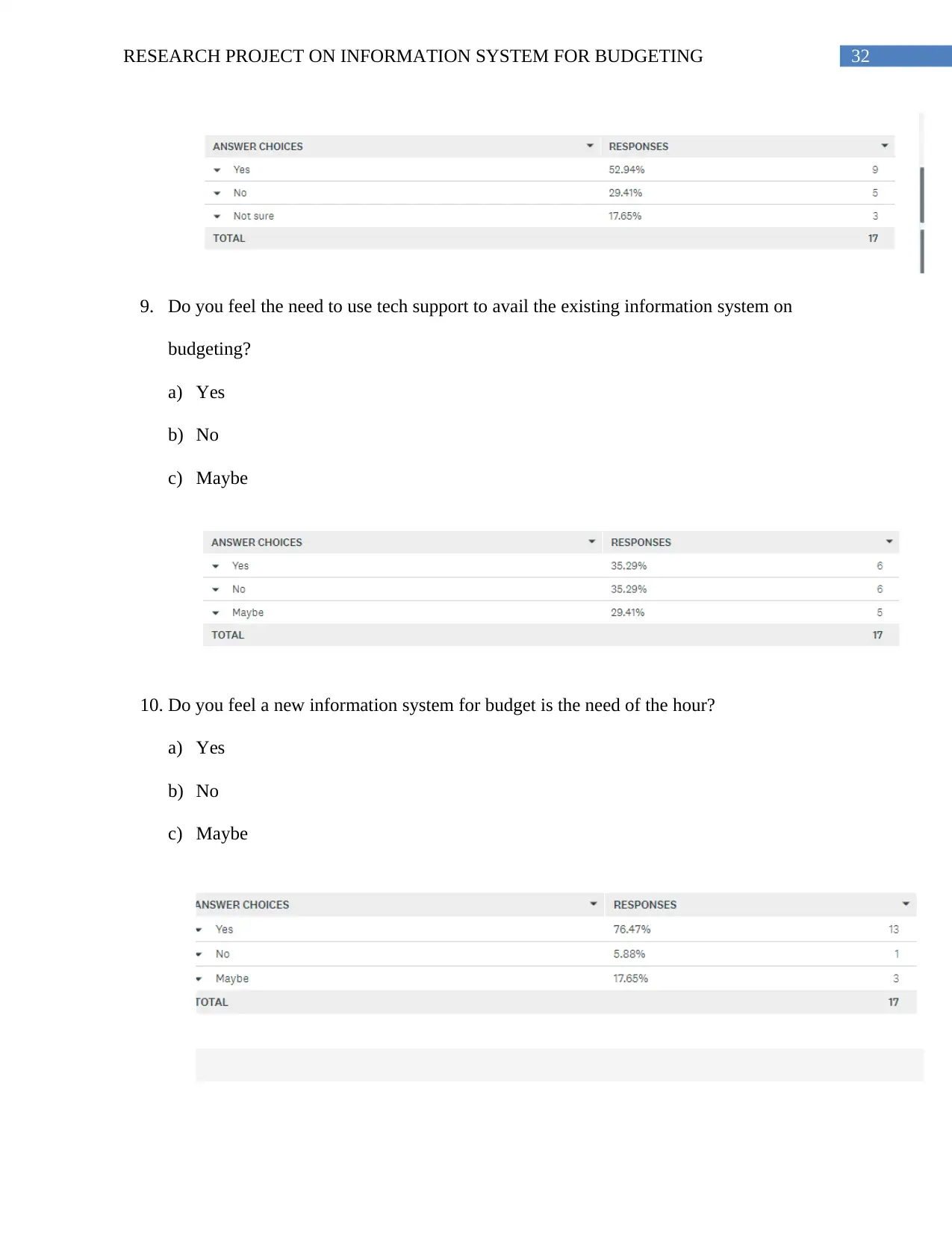
32RESEARCH PROJECT ON INFORMATION SYSTEM FOR BUDGETING
9. Do you feel the need to use tech support to avail the existing information system on
budgeting?
a) Yes
b) No
c) Maybe
10. Do you feel a new information system for budget is the need of the hour?
a) Yes
b) No
c) Maybe
9. Do you feel the need to use tech support to avail the existing information system on
budgeting?
a) Yes
b) No
c) Maybe
10. Do you feel a new information system for budget is the need of the hour?
a) Yes
b) No
c) Maybe
You're viewing a preview
Unlock full access by subscribing today!
1 out of 33
Related Documents
Your All-in-One AI-Powered Toolkit for Academic Success.
+13062052269
info@desklib.com
Available 24*7 on WhatsApp / Email
![[object Object]](/_next/static/media/star-bottom.7253800d.svg)
Unlock your academic potential
© 2024 | Zucol Services PVT LTD | All rights reserved.





